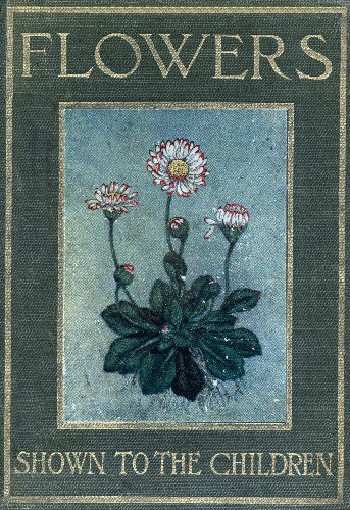
Title: Flowers, Shown to the Children
Author: C. E. Smith
Editor: Louey Chisholm
Illustrator: Janet Harvey Kelman
Release date: June 19, 2012 [eBook #40040]
Most recently updated: October 23, 2024
Language: English
Credits: Produced by Chris Curnow, Hazel Batey, Anna Whitehead and
the Online Distributed Proofreading Team at
http://www.pgdp.net

THE 'SHOWN TO THE CHILDREN' SERIES
Edited by Louey Chisholm
THE
'SHOWN TO THE
CHILDREN' SERIES
¯¯¯¯¯¯¯¯¯¯
1. BEASTS
With 48 Coloured Plates
by Percy J. Billinghurst.
Letterpress by Lena Dalkeith.
2. FLOWERS
With 48 Coloured Plates,
showing 150 flowers, by
Janet Harvey Kelman.
Letterpress by C. E. Smith.
3. BIRDS
With 48 Coloured Plates
by M. K. C. Scott. Letterpress
by J. A. Henderson.
by
JANET HARVEY KELMAN
DESCRIBED BY
C. E. SMITH
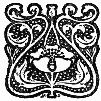
FORTY-EIGHT COLOURED PICTURES
LONDON & EDINBURGH
T. C. & E. C. JACK
TO
ALISON MARY OGILVIE
AND
DOROTHY CLARK
[Pg v]
Dear Children,—If you were old enough to go to the bookseller and ask for a book that would tell you about the flowers you see growing in the woods and fields in spring and summer-time, you would find there were already a great many books which had been written with that purpose.
If you examined a few of these books, you would discover that in many the pictures of the flowers were not coloured, and that in these books the flowers were very difficult to recognise. And I think you would at once tell the bookseller you wished a flower-book with coloured pictures, where the flowers looked like real flowers.
Then you would examine more books, some of which have beautiful coloured pictures showing every flower that grows in our country. These books are very large and cost a great deal of money. You would see, too, quite small books which said they could tell about the common flowers we find in our country walks. And I think you would buy one of these.
But next day, suppose you were to find a bright blue flower growing in the field, and wished very much to know what it was called. You would open the flower-book and begin to look at the pictures, and there you would discover that the first picture[Pg vi] showed a yellow flower, the next a red, the third a purple, a white or a blue, and you might have to turn over all the pages in the book before you found the flower you sought.
After you had looked at the picture of your blue flower, I think you would wish to know something more about the flower, and would like to read the writing to find out what it said.
But I am afraid you would not be able to understand what the flower-book told. There would be such long words telling about things you had never heard of, and you would begin to wonder if only older people could find out what books had to say about flowers.
Now this new flower-book is written just for the purpose of telling little children about the flowers. And in order to make it easy, the blue flowers have all been put together in one part of the book, the yellow in another, and the white in a third group; so you can at once know in what part of the book you will see a picture of any flower you find.
And I have made the writing which tells about each flower very easy, with as few new words as possible, so I hope you will be able to read it yourself, and find out how many wonderful and beautiful things there are in the flower-world which you might not notice unless you were told what to look for.
There are four new words you must learn to understand before you begin to read this book.[Pg vii]
The first word is CALYX, and it means a covering. When the flowers are still babies, or buds, as they are called in flowerland, they are so soft and tender that too much rain, or a cold wind or a night of frost would do them harm. So nearly every flower has been given a warm covering which is folded closely round the tiny bud to protect it. Sometimes this calyx, or covering, is all in one piece like a cup, and the bud sits safely inside. But very often it is made up of five or six or more pieces, and when this is the case, these separate pieces are called sepals.
These SEPALS are very often green, like leaves, but you may have white sepals, or yellow sepals, or blue sepals or pink sepals. You will learn all about them after you know all that is in this flower-book and are able to read a more difficult one.
The third new word you must know the meaning of, is PETALS. Nearly every flower has petals. They are the beautiful coloured leaves of the flower that are within the calyx. It is these lovely petals, pink in the rose, yellow in the buttercup, red in the poppy, and blue in the forget-me-not, that most of us mean when we talk of flowers, and it is these soft, silky petals which attract us, and not us only, but the birds and the bees and the butterflies, which all visit the gay flowers. These petals are among the most beautiful things in this wonderful world.
The fourth new word you must try to remember[Pg viii] is STAMENS. The stamens are not very attractive, but they are very important to the flower, as without them there could be no new seeds, and if there were no new seeds we should presently have no more flowers.
The stamens are usually fine, slender threads which grow either singly, or in little bunches or in a ring within the circle of petals. Each slender thread has a fat little head at the end, a purple head, or a pink head, or a red head, or, very often, a yellow head. And this stamen head is filled with fine powder which is needed to make the new seeds grow.
These four, CALYX, SEPALS, PETALS, and STAMENS, are the only new words you will have to learn in order to understand all that is written in this little flower-book, and I hope that, when summer comes, you will try to find all the plants that I have written about here, and that you will be able to tell the names, without reading them, of every flower of which Miss Kelman has made you a picture.—Yours sincerely,
C. E. SMITH
[Pg ix]
| YELLOW FLOWERS | ||
| Plate. | Page. | |
| I. | 1. Lesser Celandine, | 1 |
| 2. Bulbous Buttercup, | 2 | |
| 3. Meadow Buttercup, | 3 | |
| 4. Marsh Marigold, | 4 | |
| II. | 1. Wallflower, | 5 |
| 2. Wild Mustard, | 6 | |
| 3. Hedge Mustard, | 7 | |
| III. | 1. Yellow Horned Poppy, | 8 |
| 2. Rock Rose, | 9 | |
| 3. Opposite-leaved Golden Saxifrage, | 10 | |
| IV. | 1. Common Whin or Gorse, | 11 |
| 2. Broom, | 12 | |
| 3. Needle Whin, | 13 | |
| V. | 1. St John's Wort, | 14 |
| 2. Common Avens, | 15 | |
| 3. Tormentil, | 16 | |
| VI. | 1. Birdsfoot Trefoil, | 17 |
| 2. Hop Trefoil, | 18 | |
| 3. Lady's Fingers, | 19 | |
| 4. Meadow Vetchling, | 20 | |
| VII. | 1. Creeping Cinquefoil, | 21 |
| 2. Silver Weed, | 22 | |
| 3. Common Agrimony, | 23 | |
| VIII. | 1. Common Nipplewort, | 24 |
| 2. Autumnal Hawkbit, | 25 | |
| 3. Yellow Goatsbeard, | 26 | |
| IX. | 1. Coltsfoot, | 27 |
| 2. Common Groundsel, | 28 | |
| 3. Common Ragwort, | 29 | |
| X. | 1. Crosswort, | 30 |
| 2. Biting Stonecrop, | 31 | |
| 3. Yellow Bedstraw, | 32 | |
| 4. Mugwort, | 33 | |
| XI. | 1. Wild Mignonette, | 34 |
| 2. Common Dandelion, | 35 | |
| 3. Tansy, | 36 | |
| XII. | 1. Primrose, | 37 |
| 2. Cowslip, | 38 | |
| 3. Bog Asphodel, | 39 | |
| XIII. | 1. Honeysuckle, | 40 |
| 2. Yellow Water Iris, | 41 | |
| 3. Daffodil, | 42 | |
| XIV. | 3. Common Comfrey, | 43 |
| [Pg x] | ||
| WHITE FLOWERS | ||
| XIV. | 1. Sneezewort Yarrow, | 44 |
| 2. Mountain Everlasting, | 45 | |
| XV. | 1. Traveller's Joy, | 46 |
| 2. Wood Anemone, | 47 | |
| 3. Water Crowfoot, | 48 | |
| XVI. | 1. Shepherd's Purse, | 49 |
| 2. Common Scurvy Grass, | 50 | |
| 3. Hairy Rock Cress, | 51 | |
| XVII. | 1. Common Chickweed, | 52 |
| 2. Mouse-eared Chickweed, | 53 | |
| 3. Greater Stitchwort, | 54 | |
| XVIII. | 1. Goutweed, | 55 |
| 2. Wild Angelica, | 56 | |
| 3. Upright Hedge Parsley, | 57 | |
| 4. Hemlock Water Dropwort, | 58 | |
| XIX. | 1. Cow Parsnip, | 59 |
| 2. Wild Chervil, | 60 | |
| 3. Sea Carrot, | 61 | |
| 4. Common Hemlock, | 62 | |
| XX. | 1. Meadow Sweet, | 63 |
| 2. Wild Strawberry, | 64 | |
| 3. Wood Sorrel, | 65 | |
| XXI. | 1. Goosegrass or Cleavers, | 66 |
| 2. Woodruff, | 67 | |
| 3. Yarrow or Millfoil, | 68 | |
| XXII. | 1. Ox-eye Daisy, | 69 |
| 2. Daisy, | 70 | |
| 3. Scentless Mayweed, | 71 | |
| XXIII. | 1. Snowdrop, | 72 |
| 2. Common Star of Bethlehem, | 73 | |
| 3. Ransoms, | 74 | |
| XXIV. | 1. Mossy Saxifrage, | 75 |
| 2. Marsh Pennywort, | 76 | |
| 3. Intermediate Wintergreen, | 77 | |
| XXV. | 1. Grass of Parnassus, | 78 |
| 2. Common Bladder Campion, | 79 | |
| 3. Sea Campion, | 80 | |
| XXVI. | 1. Common Eyebright, | 81 |
| 2. White Dead Nettle, | 82 | |
| 3. Spotted Orchis, | 83 | |
| XXVII. | 2. Chickweed Wintergreen, | 85 |
| XL. | 2. Burnet Rose, | 125 |
| GREEN FLOWERS | ||
| XXVII. | 1. Red-Berried Bryony, | 84 |
| 3. Cuckoopint or Wake Robin, | 86 | |
| XXVIII. | 1. Common Mare's Tail, | 87 |
| 3. Greater Burdock, | 89[Pg xi] | |
| XXIX. | 1. Mouse-Tail, | 90 |
| 2. Ribwort Plantain, | 91 | |
| 3. Knotty Figwort, | 92 | |
| XXX. | 1. Lady's Mantle, | 93 |
| 2. Dog's Mercury, | 94 | |
| 3. Common Nettle, | 95 | |
| PURPLE FLOWERS | ||
| XXXI. | 1. Purple Sea-Rocket, | 96 |
| 2. Cuckoo Flower or Lady's Smock, | 97 | |
| 3. Marsh Cinquefoil, | 98 | |
| 4. Water Avens, | 99 | |
| XXXII. | 1. Dog Violet, | 100 |
| 2. Heartsease, | 101 | |
| 3. Common Mallow, | 102 | |
| XXXIII. | 1. Scotch Thistle, | 103 |
| 2. Marsh Plume Thistle, | 104 | |
| 3. Field Scabious, | 105 | |
| XXXIV. | 1. Common Ling or Heather, | 106 |
| 2. Black Knapweed, | 107 | |
| 3. Wild Thyme | 108 | |
| XXXV. | 1. Early Purple Orchis, | 109 |
| 2. Purple Loose-strife, | 110 | |
| 3. Common Butterwort, | 111 | |
| XXXVI. | 1. Common Bugle, | 112 |
| 2. Ground Ivy, | 113 | |
| PINK FLOWERS | ||
| XXVIII. | 2. Common Butterbur, | 88 |
| XXXVI. | 3. Hairy Water Mint, | 114 |
| XXXVII. | 1. Common Fumitory, | 115 |
| 2. Ragged Robin, | 116 | |
| 3. Red Campion, | 117 | |
| XXXVIII. | 1. Dove's-foot Crane's-bill, | 118 |
| 2. Herb-Robert, | 119 | |
| 3. Stork's Bill, | 120 | |
| XXXIX. | 1. Rest Harrow, | 121 |
| 2. Saintfoin, | 122 | |
| 3. Red Clover, | 123 | |
| XL. | 1. Dog Rose, | 124 |
| 3. Lousewort, or Red Rattle, | 126 | |
| XLI. | 1. Great Wild Valerian, | 127 |
| 2. Small Bindweed, | 128 | |
| 3. Foxglove, | 129 | |
| XLII. | 1. Broad-Leaved Willow Herb, | 130 |
| 2. Corn Cockle, | 131 | |
| 3. Cross-Leaved Pink Heath, | 132 | |
| [Pg xii] | ||
| BLUE FLOWERS | ||
| XLIII. | 1. Blue Meadow Crane's-bill, | 133 |
| 2. Milkwort, | 134 | |
| 3. Corn Flower or Blue Bottle, | 135 | |
| 4. Tufted Vetch, | 136 | |
| XLIV. | 1. Wild Succory, | 137 |
| 2. Blue Bell or Harebell, | 138 | |
| 3. Sea Holly, | 139 | |
| XLV. | 1. Germander Speedwell, | 140 |
| 2. Brooklime Speedwell, | 141 | |
| 3. Great Water Forget-me-not, | 142 | |
| XLVI. | 1. Common Borage, | 143 |
| 2. Evergreen Alkanet, | 144 | |
| 3. Wood Hyacinth, | 145 | |
| XLVII. | 1. Field Gentian, | 146 |
| 2. Sea Aster, | 147 | |
| 3. Viper's Bugloss, | 148 | |
| RED FLOWERS | ||
| XLVIII. | 1. Red Poppy, | 149 |
| 2. Scarlet Pimpernel, | 150 | |
| 3. Common Sorrel, | 151 | |
This is one of the first flowers you will see in springtime. It covers the ground in patches in every wood, and you will find it too under the hedges and on banks by the roadside.
The flower has eight long narrow petals, which are much narrower and more pointed than those of the Buttercup.
When the Celandine is still in bud the outside of these petals is beautifully streaked with purple. But when the flower opens in the sunshine, the petals are a bright yellow colour, and are as glossy as if they were wet.
In the centre of the flower there is a ring of yellow stamens with a cluster of green seed-vessels amongst them.
Behind the coloured petals are three narrow pointed sepals. These protect the flower when it is in bud.
The green leaves of the Celandine are dark and glossy, with wavy edges, and each leaf has a stalk of its own.
If you look carefully at one of these leaves you will see that the stalk is flattened at the foot. This helps it to clasp the main stem more easily.
The root is divided into five or six hard little brown fingers. These brown fingers are called tubers, and each tuber, if planted separately, will produce a new plant.
In spring the Bulbous Buttercup is found everywhere, filling the meadows with its sunshiny flowers.
Each flower has five glossy yellow petals which do not lie flat open as in the Celandine, but form a cup, a yellow cup or Buttercup.
At the base of each petal you find a small honey pouch, which the bees love to visit.
When the flower is still in bud, the yellow petals are almost covered by five pale-green hairy sepals. You can see only the yellow tips peeping out. But when the flower opens, these hairy green sepals fold back close round the stalk.
In the centre of the flower is a thick cluster of yellow-headed stamens with a knot of green seed-vessels in the middle.
The stalk on which the flower grows is slightly hairy, and has a narrow groove on one side.
The root is shaped like a small turnip, and has a great many white threads growing out of it.
The leaves of this Buttercup are dark green, with soft hairs all over them. They are shaped very irregularly, and are deeply cut up all round the edges.
The Meadow Buttercup is abundant all over the country. It grows beside the Daisy in every field and hedge-bank.
In this Buttercup the flower has five bright glossy yellow petals, which open out flat and are not cup-shaped as in the Bulbous Buttercup.
There is a hard green knot of seed-vessels in the centre of the flower, with a ring of yellow stamens all round it. When the yellow stamens and petals fall off, this bunch of seed-vessels grows bigger and bigger, until it looks like a small green raspberry.
Outside the yellow petals are five pale-green sepals. These remain close behind the yellow flower and do not fold back against the stalk as in the Bulbous Buttercup.
The flower-stalk is slightly hairy, but it is not grooved.
The green leaves are dark, and are covered with soft hairs. Each leaf is divided into three parts, which are very deeply cut up all round the edge.
You will easily recognise this Buttercup if you remember three things.
1. The flower-stalk has no groove.
2. The little green sepals do not fold back close to the stalk.
3. The root has no bulb.[Pg 4]
This is one of our handsomest wildflowers. It grows abundantly in springtime by the side of ponds, or on the marshy edge of a slow-running stream. It looks like a large, thick Buttercup.
The Marsh Marigold is closely related to the Buttercup family, though it differs from the Buttercups in various ways.
The five bright yellow petals of the flowers are glossy, and have little veins running up from the bottom.
In the centre of these petals there is a big bunch of yellow stamens, with a group of green seed-vessels amongst them.
If you look at the back of an open flower you will see that there are no green sepals such as there are in the Buttercups.
The flower-stalks are thick and hollow, with ridges along the sides. They snap off easily when gathered, but very soon they lose their stiffness and become soft and flabby. This means they are thirsty, and if you give them plenty of water to drink they will soon be as stiff as when they were growing.
The green leaves of the Marsh Marigold are dark above, but underneath they are much lighter. They are very glossy and smooth, and each leaf is covered with a fine network of veins.
In shape they are like a heart with crinkled edges.
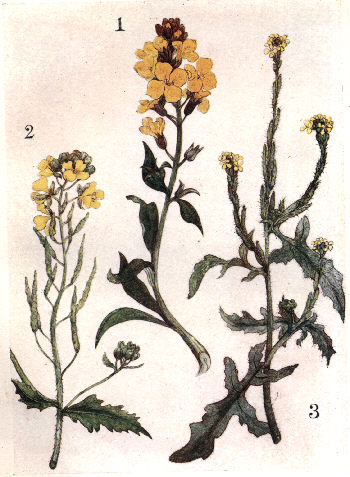 1. WALLFLOWER. 2 WILD MUSTARD.
1. WALLFLOWER. 2 WILD MUSTARD. The Wallflower, as its name tells you, likes to grow on walls. In early spring you will see it on the top of old walls or high up on the broken roof of a ruined castle. How did it get there? The wind or the birds must have carried the seed.
The flowers are a rich golden yellow, and they have a delightful scent. Each flower has four beautiful petals, which are broad above with a long strap forming the lower part.
In the centre where these four petals meet, you can just see the tips of the stamens peeping out: but the seed-vessel is hidden from sight.
The four sepals are a dark purple colour, and they form a cup in which the lower or strap-shaped part of the petal is held.
Those flowers which are nearest the foot of the stem open first. You will often find eight or ten yellow flowers blooming at the same time and a bunch of dark purple buds at the end of the stem.
The stem of the Wallflower is tough and woody near the ground, but further up it is green and smooth.
The leaves are narrow pointed straps with smooth edges. They are dark green, but sometimes they have a touch of purple at the tips.[Pg 6]
This is a plant the farmers are very sorry to see. They do not want it among the corn, but in springtime the fields are often covered with its yellow flowers.
The flowers grow in a cluster near the top of the stem. There are often four or five in full bloom at once, gathered round a bunch of green buds which rises in the centre of the cluster. While the first cluster is in flower, the stem continues to grow, and by the time these flowers fall off, another cluster appears at the end of the lengthened stem, and so on.
If you pull off one of the flower-petals you will see that the lower half is strap-shaped. But the petal is much broader at the other end, and it is round, with a tiny nick in the outer edge.
In the centre there are six stamens whose tips you can just see where the four petals meet. But the seed-vessel is hidden until the petals and sepals and stamens fall off. It then grows into a thin green pod, and you will find many of these slender pods standing out from the hairy stem.
Behind the yellow petals are four thin sepals. When the flower is fully out these lie flat open. They do not form a cup.
The leaves of the Wild Mustard are dusty green. They are each in one piece and are broadly pointed, with the edges cut like the teeth of a saw.[Pg 7]
This is a very common little plant, but it is not at all attractive. You find it by the roadside and in waste places in early summer, and it always looks very dusty.
The flowers are quite small. They grow in little clusters at the end of a long spike, and there are usually four or five flowers out at the same time. These flowers have each four tiny petals of a pale yellow colour, and unless you look very closely, and pull these petals gently apart, you will not see either the stamens or the seed-vessel, which are almost hidden from sight.
The little green sepals at the back of each flower stand straight up from the stalk and form a cup. This cup has slits down the sides and it holds the flower.
The stalk is almost covered with thin, hairy, green pods pressed closely against it. These pods hold the seeds, and they look like green caterpillars creeping up each side of the stem.
The leaves of the Hedge Mustard are a dull grey-green colour and are very rough and hairy. Those nearest the ground have no stalks, they grow like a rosette, with one leaf close above another.
But the leaves further up the stem are each separate. They are very much cut up, and their edges are toothed like a saw.
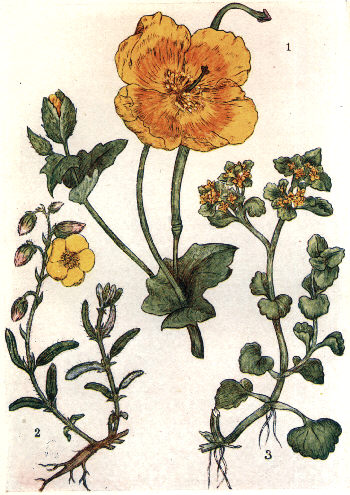 1. YELLOW HORNED POPPY 2. ROCK ROSE
1. YELLOW HORNED POPPY 2. ROCK ROSEThe Yellow Horned Poppy grows all summer on sandy seashores or among stones. It is a showy plant, with large, orange-yellow flowers.
Each flower has four petals which open almost flat. These petals are very soft and are daintily waved round the edges.
In the centre of the petals rises a big bunch of stamens. In the middle of these stamens stands a curious green horn. This is the seed-vessel, and it is divided at the tip into three little forks.
As soon as the yellow stamens and the petals fall off, this horn grows into a long curved pod, and in this pod are the seeds.
The Horned Poppy has two green sepals which are very rough and hairy. They cover the flower so long as it is in bud, but whenever the flower begins to expand these sepals burst open, and as soon as the yellow petals have smoothed out their crinkles in the sun these little green coverings fall off.
The leaves of this Poppy are thick and leathery, and are covered with hairs which make them look grey.
These leaves have no separate stalks, but grow close to the stem as if they were clasping it.
This is a delicate little branching plant which trails in summer-time along the ground, on grassy hills, and among rocks and gravel.
The flowers grow singly on short stalks, and each flower has five bright yellow petals which lie flat open. These petals are not stiff and glossy like those of the Buttercup, but soft and easily crinkled like the Poppy petals.
If you touch very lightly the yellow stamens in the centre of the flower, they will spread out and lie down.
The Rock Rose has five little green sepals. Three of these have their tips slightly tinged with pink, and these pink-tinged sepals are large enough to cover the flower when it is in bud. The other two are much smaller, with sharply-pointed tips, and they grow at the end of the little flower-stalk behind the pinky sepals.
The leaves of the Rock Rose are long and narrow with smooth edges, and they grow opposite each other on the stem.
These leaves are always dark green above, but underneath they are covered with fine white woolly down, and if you hold them up to the light you will see that the edges are fringed with soft hairs.[Pg 10]
This small plant grows in damp places by the side of ditches and on wet rocks. It is commonest in the north of Britain, but in spring you will find its soft stems creeping close to the ground in the south of England also.
The Golden Saxifrage has no petals. The yellow flowers grow at the end of the stem in small clusters, which are sunk among the leaves.
Each flower has a yellow calyx tube, which is divided at the mouth into four parts. These divisions are yellow inside, but on the outside they are green.
There is a ring of tiny stamens standing out all round the mouth of the calyx tube, and in the very centre of the flower stands a fat seed-vessel, like a beak, which splits open into halves when the seeds are ripe.
The leaves of the Golden Saxifrage grow in pairs on each side of a pale green, juicy stem.
This stem is covered with clear white hairs. The leaves are pale green and are round in shape, with crinkled edges. They are very soft, and, like the stem, they have fine white hairs all over them.
When you gather a handful of the Golden Saxifrage you find a great many slender white roots hanging from the stem wherever it has lain along the ground.
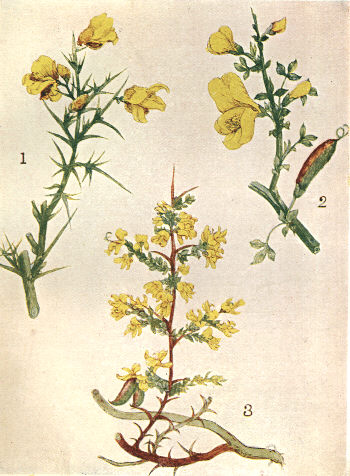 1. COMMON WHIN OR GORSE. 2. BROOM.
1. COMMON WHIN OR GORSE. 2. BROOM. This is a shrub children like better to look at than to gather. It is very common on heaths and banks and in dry fields, and it blooms in early summer.
The flowers are curious, because the five petals are so strangely shaped. One broad petal stands up highest and is called 'the Standard.' Then there are two narrow petals at the side; these are called 'Wings.' And in between these narrow petals there are two joined together like a tiny boat, which are called 'the Keel.'
There is a bunch of curved stamens with their slender stalks all joined together at the bottom into a green tube.
Amongst these stamens you can see the tip of the seed-vessel.
When the flower is in bud it is enclosed in a rough, yellowish-green covering which has many black hairs all over it. This covering usually opens in two pieces, and these pieces remain below the flower until it is withered.
Instead of leaves the Gorse has many sharp prickly spikes or leaf-thorns. You will notice that there are many of these sharp spikes which have little groups of two or three shorter spikes branching from them, and each branch ends in a sharp spike.[Pg 12]
This is one of our most beautiful spring shrubs. It grows on heaths and by the roadside, and sometimes you will see a low hill covered with it, and glistening like gold in the sunshine.
The flowers are very like those of the Common Whin, but they are much larger, and the yellow colour is deeper and more golden.
The petals are shaped the same as in the Common Whin, and if you look at the green tube into which the stamens are joined, you will see that it has a curious green thread at the end which is twisted into a curl. The seeds are in this tube, and when the petals and stamens have all fallen off, this tube becomes a flat green pod tinged with purple. The curly green thread still remains at the end.
There are green sepals at the back of the flower which form a cup. This cup looks as if it was only in two pieces; but, as in the Common Whin, it is really made up of five sepals, and you can often see five little teeth at the mouth which show where each sepal begins.
The leaves of the Broom are very small, and they grow in groups of three. Those close to the flowers have no stalks, but the others have each a stalk with the three little leaves at the end.[Pg 13]
The Needle Whin is not so well known as the Common Whin or the Broom, though it belongs to the same family. It is very common, and you will find plenty of it in spring and early summer growing close to the ground among the heather.
The flowers are pale yellow, with six petals very like those of the Common Whin or the Broom, only much smaller. You find five or six flowers growing close together on a trailing woody stem.
Each flower sits in a green cup, which is made up of five sepals joined together. Round the mouth of the cup are five sharp teeth, and you can see, much more clearly than in the Common Whin or in the Broom, where each separate sepal begins.
After the petals and stamens fall off, the seed-vessels grow into large, fat pods which are commonly tinged with purple.
If you are not in the country until the petals have fallen, you will easily recognise the Needle Whin by these fat pods. Sometimes five or six or more grow near the top of each short stem.
The leaves of this tiny Whin are very small and have scarcely any stalks. Growing up the main stem are many very fine spines or leaf-thorns, as sharp as needles.
From these the plant gets its name.
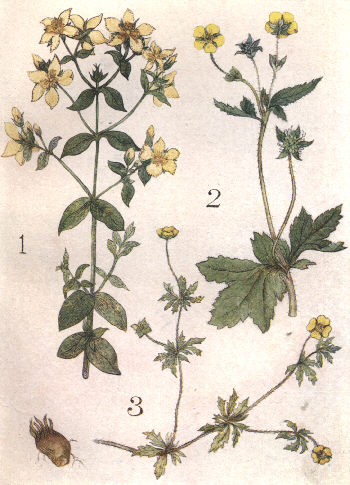 1. ST. JOHN'S WORT. 2. COMMON AVENS.
1. ST. JOHN'S WORT. 2. COMMON AVENS. This is a tall, handsome plant, whose flowers appear late in summer among low-growing bushes or on the hedge-banks.
Each flower has five pale yellow, pointed petals, which open like a star. On these petals there are often many small black dots.
The flowers grow on short stalks, which always rise between a small green leaf and the stem. These flower-stalks are in pairs, exactly opposite each other on each side of the stem.
Inside the flower there are a great many stamens. These stamens are grouped in bunches, and do not form a ring all round the centre as in many flowers.
Seated among these bunches is a pear-shaped seed-vessel with three horns at the top.
At the back of the flower, lying flat open, are five thin green sepals, whose tips you can see appearing, as you look down into the flower, between the yellow petals.
The stalk is smooth and stiff, with two edges which look as if the sides had been joined together.
The green leaves grow in pairs opposite each other. They taper to a point and have edges that are smooth all round. If you look closely you will see that each leaf is covered with tiny black dots.
There is another St. John's Wort very like this, but its stalk is square, with four edges.
The Common Avens grows abundantly all summer in woods and on shady hedge-banks, but it is not very attractive.
The flowers are small, with five separate yellow petals which lie flat open. As you look down into the flower, you can see the tips of the five green sepals appearing between the yellow petals.
Each flower grows at the end of a short stalk, but two or three of these stalks often spring from the main stem at the same place.
Half way up this stem you will find a pair of tiny green leaves with very small buds appearing between them and the stalk. These buds will come out later, when their stalks have time to lengthen.
In the centre of the ring of stamens there is a small green bunch of seed-vessels. Each seed-vessel has a thin stiff hair at the top, and after the yellow petals fall off you will see this bristly bunch of spikes still at the end of the flower-stalk, with the tiny green sepals standing out like a frill behind.
Each leaf is divided into three or more parts. Those close to the ground are large and coarse, with the edges cut like the teeth of a saw.
But there are leaves further up the stem, and these are frequently divided quite differently from the root leaves.[Pg 16]
This is a dainty little plant which grows all summer in open woods, and on heaths, where its masses of small yellow flowers look like gold stars among the tangle of green leaves and stems.
The flowers are small, with four pale yellow petals which lie wide open, and rising from amongst them there are yellow stamens with a bunch of green seed-vessels in the centre. Behind these yellow petals there is a green star-circle of sepals. Four of these sepals are long and green, and their tips can be seen in front between the yellow flower-petals.
There are also four much smaller green sepals which stand between each of the larger ones, so the calyx is really a beautiful green star with eight points.
Each flower has a stalk of its own, and each stalk rises from between a leaf and the stem. Sometimes they are deeply tinged with purple.
The green leaves of the Tormentil are soft and fine, with a few downy hairs on the front. They are divided into five fingers, and each of these fingers has its edges cut into large teeth all the way round.
Very often these edges turn quite yellow when the plant is just beginning to fade.
The Tormentil root is rather curious. It looks like a thick brown finger, but if you cut it, the inside is a delicate rose red.
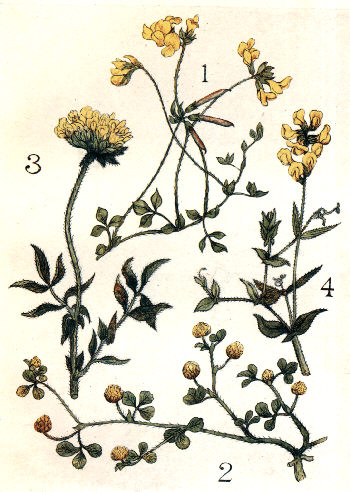 1. BIRD'S FOOT TREFOIL. 2. HOP TREFOIL
1. BIRD'S FOOT TREFOIL. 2. HOP TREFOILThe golden Birdsfoot Trefoil grows nearly everywhere. You can gather its tufts of bright yellow flowers all summer in the fields and woods and waste places.
The flowers grow in heads at the end of a long flower-stalk, and each head may have from four to eight flowers close together in a bunch.
The five petals are golden-yellow streaked with red, and they are strangely shaped. There is one big petal which stands up behind. Then there are two long-shaped petals which lie sideways, and two small ones that are joined together in a curious point.
After the petals fall off, the seed-vessel in the centre of the stamens grows into a long, thin red pod; and when there are four or five of these narrow pods at the end of the flower-stalk, they look like the claw of a bird.
That is why this Trefoil is called Birdsfoot.
The leaves are very pretty. There is a single small green leaflet, with smooth round edges, at the end of a short stalk. Just below this little leaflet there is a pair of tiny leaflets. And further down, where the stalk joins the main stem, you will find still another little pair. So that the name Trefoil, which means 'three leaves,' is not correct, as there are really five small leaflets on each short stalk.[Pg 18]
The Hop Trefoil is a cousin of the Birdsfoot Trefoil, and is quite as plentiful. It grows all summer by the edge of the fields and in grassy pastures.
You will easily recognise it by the flowers. These cluster together in small round yellow heads like a tiny clover. In each head there are from twenty to forty little flowers closely packed together. When you pick one of these tiny flowers to pieces, you find that the petals are very much the same as those of the Birdsfoot Trefoil. But they are so small that you would require a magnifying glass to see them clearly, and to discover the stamens and seed-vessels which are hidden inside.
When the flowers begin to fade, the petals do not fall off at once, but they shrivel and become a pale-brown colour. Sometimes you find a flower of which the lower half is quite brown and withered, while the upper half remains golden yellow.
At the end of the flower-stalk you find a small oval green leaflet, and close below this single leaflet comes a pair of dainty leaflets. On each stalk there is always this triplet. The main stem is covered with fine downy hairs, and you will notice that wherever a leaf-stalk joins this stem there are two small green sheaths with points, which look as if they were meant to cover the join.
This showy plant grows abundantly all summer on dry banks and pastures. You will easily recognise it by the large heads of pale yellow flowers with their woolly sepals.
The flowers are grouped in two heads at the end of a stout stalk, and there are usually ten to twenty separate flowers in each head. The petals seem very similar to those of the Trefoils, but each petal ends in a long claw, and these claws are hidden in the cup formed by the sepals.
This calyx-cup is edged round the mouth with sharp teeth, and it is covered with grey fluffy down. The grey down gives a woolly appearance to the flowers.
You also find a frill of narrow green pointed leaves without stalks underneath each head of flowers.
When the petals and stamens have fallen off, the yellow calyx-cup becomes much swollen, and inside it there remains a small pod which bears the seeds.
On the upper side the leaves are a delicate blue-green, with fine silky hairs all over them. But underneath these leaves are much paler. Each leaflet is long and narrow and is placed the one opposite the other on the leaf-stalk, at the end of which there is always a solitary leaflet.
The Meadow Vetchling is not nearly such a stout plant as the Lady's Fingers. Its stem is feeble and requires to find support by holding on to the hedges, or to some other strong plant.
The flowers are a beautiful golden yellow. They grow in loose bunches near the end of a straight, stiff flower-stalk. Notice that all the flowers face one way, and that in each flower the largest yellow petal is daintily streaked with purple.
You cannot see either the stamens or the seed-vessel, which are hidden inside the flower.
The sepals are joined so that they form a green cup which has five sharp points round the mouth.
The leaflets grow in pairs at the end of the leaf-stalk. They are long and narrow, like a lance, with fine lines running from end to end. In between each pair of leaflets you find a green twisted thread called a tendril. This tendril curls round the stem of plants that are stronger than the Meadow Vetchling, and they support it.
Wherever the leaf-stalk joins the main stem you will find another pair of green leaves. These leaves are shaped like the head of an arrow, and they have a name of their own, which you will learn when you know more about plants.
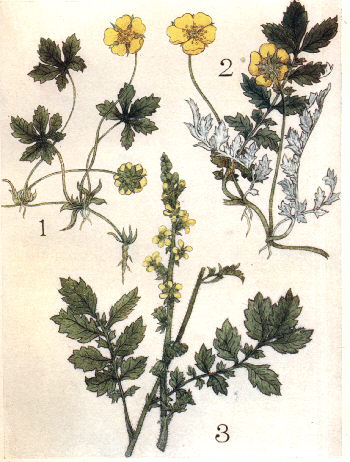 1. CREEPING CINQUEFOIL 2. SILVER WEED
1. CREEPING CINQUEFOIL 2. SILVER WEED This pretty plant is common everywhere. You will find it all summer by the roadside, in meadows, and by the edge of the cornfields.
The flowers are bright golden yellow: they have five petals which open out like a rose, and in the centre there is a ring of yellow stamens with a knot of green seed-vessels among them.
In between each of these yellow petals you see a narrow green point appearing. These are sepals, and if you look at the back of the flower you find that the calyx is really a star made up of ten pointed green sepals.
The flowers grow on long, slender stalks. Both the flower and the leaves rise from what looks like another slender stalk creeping close to the ground. The creeping stalk comes from a root which resembles a small carrot. This root goes straight down into the ground, and it sends out three long, stalk-like creepers which lie along the surface. Wherever a bunch of leaves and flowers rises from the creeper, two or three little white roots go down into the ground. These take firm hold of the earth and help to keep the plant steady.
The leaves are beautiful. Each leaf is divided into five fingers, which are cut round the edges like the teeth of a saw. They are dark green, and have long, slender stalks like the flowers.
The Silver Weed prefers to grow in damp meadows and on the banks of ditches. You find it in abundance all summer.
The flowers are not unlike those of the Cinquefoil. They have five golden yellow petals which are not cup-shaped, but lie flat open. These petals are larger than those of the Cinquefoil, and you can only see the smallest tip of the green sepals appearing in between each.
There are really ten sepals in the calyx. Five of these are narrow little pointed leaves, but the others are each divided at the tip. If you remove all the yellow petals, this green calyx, with its ten green points, is just like a beautiful star.
The Silver Weed sends out long creepers. These are thicker than in the Cinquefoil, and are often tinged with pink.
When the leaves are half-open they look almost entirely white, because they are covered with a fine silvery down. But when they are fully out they become dark green above, and it is only the underside which remains white and silvery.
Notice that the leaves grow in pairs, with big leaflets and very little leaflets alternately on each side of the leaf-stalk, and that their edges are deeply toothed all round.
This plant likes to grow in dry places, such as hedge-banks or at the side of fields, and it blooms in summer.
The flowers grow one above the other on a tall spike, and they look like small yellow stars. Those that grow lowest down on the spike come out first, and the small green buds are crowded together near the top.
In the centre of the five yellow petals there is a ring of stamens, and amongst those stands a fat, green seed-vessel with two horns at the top.
The calyx or green covering of the flower is the part you must notice most closely.
It rises from a short stalk, and is shaped like a bell. There are ten deep lines running from top to bottom of this green bell, and round its mouth there are five large points.
Below these points is a curious ring of tiny hooks like a fringe, and these cling to whatever touches them. You often find a dozen of these little green bells fastened to your skirt if you have been where the Agrimony grows.
The leaflets are dark and hairy. They grow opposite each other in pairs, on each side of the leaf-stalk: first a large pair, then a small pair, turn about, and you always find a single large leaflet at the very end.
Each leaflet is deeply cut round the edge and has teeth like the teeth of a saw.
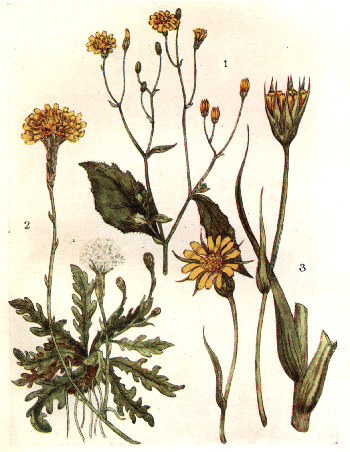 1. COMMON NIPPLEWORT 2. AUTUMNAL HAWKBIT
1. COMMON NIPPLEWORT 2. AUTUMNAL HAWKBIT The Nipplewort is very common everywhere. It grows both in waste places and in cultivated ground or by the roadside, and you find it in flower all summer and autumn.
It has a slender round stem, which branches a good many times, and at the top of each of those branches you find a tiny yellow daisy. These daisies are made up of many yellow tubes, each with a broad yellow strap at the mouth. The straps have the edges cut into sharp teeth, and they stand out in a circle all round the small yellow daisy.
The small yellow heads are held by a green cup made up of two sets of narrow pointed green leaves, and you will notice that there is always a single very tiny grey-green leaf where each branch forks from the main stem.
The leaves of the Nipplewort vary much in shape. Some are like a feather of which the lower part is cut away almost to the centre stalk. Others are regularly oval, with wavy edges all round, and these leaves end in a sharp point. They are dark green in colour, with hairs all round the edge.
The Hawkweeds are a very large family, and it will be a long time before you learn to recognise them all.
The Autumnal Hawkbit is the commonest, and it is found nearly everywhere, in meadows, in pastures, and in waste places. It flowers in late summer and autumn.
The leaves grow in a rosette close to the ground. They are dark green, rather smooth, and are shaped like narrow feathers, with the edges irregularly cut into deep, rounded teeth. They all spring from the centre root.
The heads of yellow flowers grow on tall, slender, wiry stalks. Very tiny scale-like green leaves grow up the stalks at intervals. Each yellow head is made up of many small yellow tubes with a strap at the mouth, and these strap tubes are crowded together all over the flower-head.
When the yellow flowers are withered, the seed-vessels remain, each with a tuft of feathery cotton down attached to it But the down ball is not a perfect one as in the Dandelion; and the down looks grey.
The top of the flower-stalk is clothed with layers of narrow pointed green leaves which are tinged with red, and are sometimes woolly. These layers are pressed tightly one above the other like the scales of a fir-cone, and they cover the yellow flower completely when it is in bud.
The Yellow Goatsbeard is fairly common in this country. It grows in meadows and pastures and in waste places, and it is in flower all summer and autumn.
It belongs to a large family of plants which are very difficult to distinguish the one from the other, and you will find several Goatsbeards that seem very much alike.
This Goatsbeard is a wiry, straight, slender plant. The dark green stem is round, and the leaves grow close to it without stalks. These leaves are like a broad blade of grass at the bottom where they join the stem, but near the top they get very narrow and are folded together, so that they appear almost round, and they end in a sharp point.
The flowers grow singly on round, smooth stems. They look like small Yellow Dandelions with fewer yellow rays, and like the Dandelion they are made up of many little yellow tubes grouped together, some of which have yellow straps at the edge, while others have none. When the flower is half open you will notice that it stands in a green cup made up of eight narrow leaves with long, fine points. These points are much longer than the yellow rays of the flower, and stand up beyond them when the flower is closed. The flowers of the Goatsbeard have the curious habit of closing at midday, even when the sun is shining.
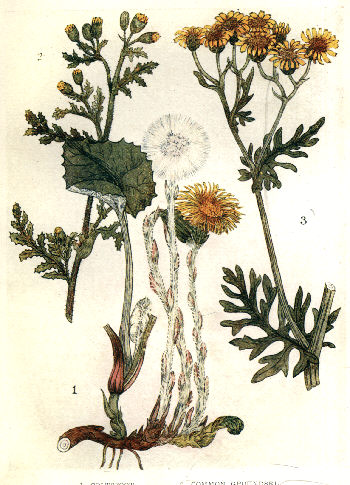 1. COLTSFOOT 2. COMMON GROUNDSEL
1. COLTSFOOT 2. COMMON GROUNDSEL The Coltsfoot is a very common plant. You find it all over the country, and along with the Celandine it is one of the first flowers to appear in spring. The flowers come out before the leaves. They grow singly at the end of straight, woolly stalks which have many little pink scale-like leaves, from top to bottom. When the flowers are withering, their heads begin to droop; but when the downy seed-ball is ready to open, the flower-stalks stand straight up again.
The flowers are bright yellow, and like the Daisy and Dandelion, which belong to the same family, they are made up of a great many tiny tubes grouped close together. Those tubes round the edge have a long, narrow, yellow strap at the outside.
After the flowers are withered, the seeds remain at the end of the stalk, and each seed sends out a tuft of beautiful, straight, white down which forms a delicate ball as in the Dandelion. But the Coltsfoot down-ball is neither so starry nor so beautiful as that of the Dandelion.
The leaves of the Coltsfoot are entirely covered with cotton wool when they are small; as they grow bigger, they become glossy grey-green above, and are white only underneath.
Each leaf is nearly round, with beautiful pointed scollops at the edge, and it has a long stalk.
This plant is one of the very commonest we have. It is in flower all the year round, and grows everywhere. We have all gathered it to give to the canaries, who love to pick the tiny seeds.
The Groundsel flowers grow in small heads of two or three together at the end of short stalks which branch at intervals from top to bottom of the stem. These stalks are not very strong, and as the flower-heads are heavy, they make the stalks bend over.
This is another plant whose flowers are composed of a great many small tubes tightly packed together. These tubes are yellow, and some have a broad, short strap at the mouth of the tube, and in some the mouth is evenly nicked all round. They grow in a tiny green cup, which is made up of narrow strap-shaped green leaves tightly pressed together, and you can only see the tips of the yellow flowers at the mouth of this cup. After the flowers are withered, a bunch of white down is seen coming out of the mouth of the green cup.
The stem of the Groundsel is soft and juicy, and it has a good many hairs upon it.
The leaves are glossy dark green, and are shaped like a feather, with large, regular divisions up the sides. Each division is finely waved all round the edges.
The Ragwort is a very common plant. It grows everywhere, and is in flower in late summer and autumn.
It is a stout and rather coarse plant, with bunches of small yellow daisies growing on short forks which branch from the top of the main stem.
These daisies are rather poor looking, and they are made up of a great many little flowers crowded together inside a green cup, and a few of the flowers round the edge of the cup have yellow straps which are thin and straggling.
The yellow tube flowers in the centre are evenly nicked all round the mouth, and they have yellow stamens whose heads you can see forming a circle round the yellow tip of the seed-vessel with its two curled points.
The stems of the Ragwort are sometimes white and woolly, and they are covered all over with deep ridges.
The leaves are dark green and shiny. They are long and feather-shaped, and are deeply cut up almost to the centre rib, forming narrow green horns on each side of it.
 1. CROSSWORT. 2. BITING STONECROP.
1. CROSSWORT. 2. BITING STONECROP. The Crosswort is common in England and in the South of Scotland, but it does not grow far North. It is in flower all spring and summer, and you find it abundantly in woods and thickets. This is rather a soft, weak plant, which you will easily recognise by the curious way the leaves are placed on the stem.
These leaves are small, and pointed, and they grow in form like a cross. The crosses appear about an inch apart all the way up the stem, and their leaves are soft and thin, and are covered all over with fine hairs.
The flowers grow in clusters on very short stalks close to the stem where the four leaves meet. They are yellow and very tiny. Each flower has four petals, and these petals are joined together and show four points standing out round the edge. You will notice four tiny stamens, one of which lies flat between each of the petals, and there are also two narrow green leaves springing from among the small groups of flowers, as well as the four which form a cross.
The stem of the Crosswort is four-sided, and, like the leaves, it is covered with fine hairs.
The Biting Stonecrop is common all over Britain. It is abundant in summer on rocks and in sandy places by the seaside, and you find it growing inland too.
The Stonecrop grows in large tufts close to the ground. It is a small plant with a great many little branches, and these branches are of two kinds. Some are thickly covered with fat, juicy leaves. These leaves are very tiny, and they are laid thickly all round the stem in the same way as the scales are laid on a fir-cone. Those leaves nearest the end of the branch are often tinged with red.
On the other branches of the Stonecrop the fat green leaves are not nearly so closely packed together, and near the end of each branch grow two or more flowers.
These flowers are golden yellow, and they have five pointed petals which resemble the rays of a star, and there are ten yellow stamens lying flat out, on and between these petals.
In the centre of the flower you see five fat little seed-vessels standing up. After the yellow petals have all fallen off, these seed-vessels lie down and show five points like a small green star.
The Yellow Bedstraw is to be found all over the country. It grows in pastures, and on the hedge-banks, and it is in flower all summer and autumn.
There is a white bedstraw as well as a yellow, and you will often find great masses of both growing like a carpet on the grassy hedge-banks. The stems of the Yellow Bedstraw are not strong, although they grow to a great length, and the plant is usually lying in a tangled mass near the ground.
The flowers are very tiny. They grow in dense clusters. Each cluster has a short stalk which branches opposite another stalk on the main stem. The flowers have four petals and four stamens, and these stamens have almost no stalks. They look just like dots lying on the yellow petals.
The leaves of the Yellow Bedstraw are very tiny. They resemble small green straps, and they grow in circles, with eight to ten leaves in a circle round the main stem, close to where the flower clusters grow. You also find a circle of leaves growing on the short stalks which hold the clusters of flowers. These tiny leaves are hairy underneath.
The Mugwort, or Wormwood as it is often called, is common all over the country. It grows in waste places and by the borders of the fields, and it blooms in autumn.
You will easily recognise this plant by its greeny-white woolly flowers, with their yellow or red centres. These flowers grow in short clusters, and each little woolly head is made up of a number of separate flowers shaped like tubes. These yellow or red tubes are grouped together as in the Daisy.
The stem of the Mugwort is pale green, and has red ridges running from end to end. The leaves are very handsome. They are large and broad and feather-shaped, with big leaflets in pairs opposite each other on the stem, and there is always a single long leaflet at the end. Each of these leaflets is deeply cut round the edges into large teeth.
The back of the Mugwort leaves is covered with silvery white down, and often the green edges are curled back on to this white underside.
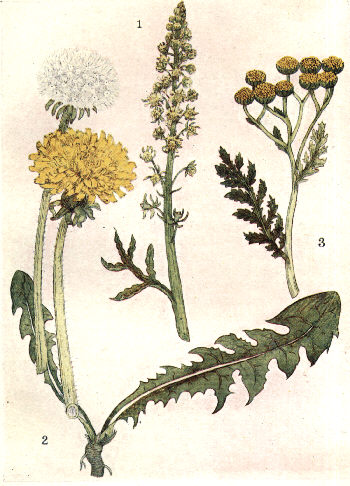 1. WILD MIGNONETTE 2. COMMON DANDELION
1. WILD MIGNONETTE 2. COMMON DANDELION The Wild Mignonette does not grow close to the ground like the sweet-scented Mignonette we have in our gardens. It is a tall, spiked plant, which you find in summer-time on waste ground and among stone heaps, and it is not at all noticeable.
The flowers grow on short, thin stalks. Those flowers at the bottom open first, and the little buds are always at the top of the tall spike.
These flowers are little yellow balls, which seem to be entirely made up of stamens. But if you gently pick one of these yellow balls to pieces, you will find that there are six greenish-yellow petals.
The four largest petals are so deeply cut round the edge that they appear to be fringed. But there are two long thin ones which are each in one piece. These petals are all joined together at the bottom, with the bunch of fluffy stamens and the seed-vessel inside.
Behind this little ball there are six thin green sepals. These are very narrow and pointed, and they stand round the flower like the legs of a spider.
The leaves are dark green, and they are very much lighter underneath than above. They are very narrow, with crinkled edges, and the upper half of the leaf branches into three or four parts, like a stag's horn.
The Dandelion is as well known as the Buttercup and Daisy. It grows in all kinds of places, and it is in flower from early spring to late autumn. The large yellow flower-heads are made up of a great many separate little flower-tubes, which widen out at the mouth into a long yellow strap. These yellow tubes are placed on a round disc with the straps standing out in a circle, like a rosette. Each flower-head grows singly at the end of a long green stalk. The stalks are hollow, and when you break them a white milky juice oozes out. At the top of the stalk you find a cup made up of narrow pointed green leaves. Some of these leaves curve back over the top of the stalk.
When the yellow flowers are withered, the round disc is covered with the tiny seed-vessels. Each seed-vessel ends in a slender green spike which has a beautiful tuft of starry down at its tip. This ball of starry down is one of the most beautiful things in the flower world.
The leaves of the Dandelion are a smooth glossy green. They are shaped like a blunt arrow-head, and they have a white line running up the centre. The edges are cut up into huge teeth which are said to resemble the teeth of a lion. From this the plant gets its name.
The Tansy is to be found in hedge-banks, and by the roadside, or on the borders of the fields in many places all over the country, though in the North it is not very common. It flowers in autumn, and is a tall, bushy plant, with large green, ferny leaves.
The Tansy has a short, green stem rising stiff and straight from the ground, and this stem branches at the top into three or four forks. Each of these forks divides again into two or three smaller forks, and there is a flower which looks like a yellow button at the end of each fork.
If you pick one of these yellow buttons to pieces you find that it is made up of a great many yellow tubes, with a swollen green part at the bottom. These yellow tubes are of two kinds. In some the mouth of the tube is cut evenly all round into small scollops, and in others there is a yellow strap at one side of the tube. These tubes stand on a round disc, and at the back of this disc there is a thick double row of small green pointed leaves, which form a green cup behind the yellow buttons.
The leaves of the Tansy are like coarse ferns. They are feather-shaped, with deeply cut divisions, and each division is toothed at the edges. The Tansy has a strong scent, especially when you crush its leaves or stalks.
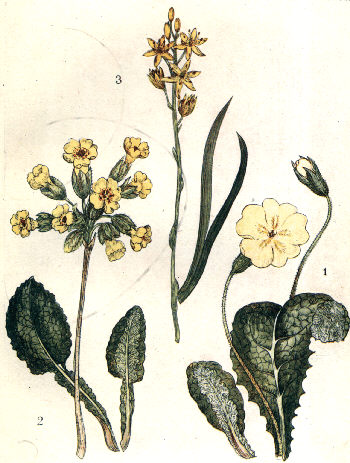 1. PRIMROSE. 2. COWSLIP.
1. PRIMROSE. 2. COWSLIP. Is there any child who does not know the Primrose? In spring and early summer you will find its yellow blossom starring the woods and hedge-banks, and you will see it too by the seashore.
The flowers grow singly on fine stalks rising from the middle of the root. A long yellow tube is hidden in the deep calyx-cup, and the mouth of this tube opens out into five pale lemon-yellow petals. Each petal has a notch in the outer edge, and there are two orange-coloured streaks running from the base. In the centre of the petals, you can see the mouth of the tube with the heads of the stamens in its throat. The slender thread with its pinhead top, which rises from the seed-vessel, can just be seen. Yet you will also find Primroses where the heads of the stamens are hidden from sight, but where this seed-vessel thread reaches beyond the mouth of the tube.
The calyx-cup is pale-green and hairy, and has fine, sharp teeth round the edge.
The Primrose leaves grow in a rosette, rising with short, juicy stalks from the root. They are covered with a fine network of veins, which are much raised on the underside of the leaf. The leaf is crinkled all over.
Before the leaves are full grown, the edges are often rolled back so as nearly to meet on the silvery underside.
The Cowslip is the Queen of our meadow flowers. It is common in England and Ireland, and in many parts of Scotland. The spring, or early summer, is the best time to find it.
The flowers grow, a dozen or more together, in a loose cluster, at the end of a stout, round stalk. Each flower has a yellow tube which is sunk out of sight in a swollen calyx-cup. This cup is a beautiful light green colour, with five sharp teeth at the mouth, and it is covered with soft hairs. Sometimes you find it tinged with brown streaks.
Round the mouth of the yellow flower-tube stand five small lemon-coloured petals, each with a V-shaped nick in the outer edge, and a bright, reddish-orange spot at the base. If you look at the back of a cowslip, you will see that the yellow tube is swollen just below the petals.
There are five stamens, whose heads are just visible in the throat of the tube, with the tip of the seed-vessel amongst them. In some flowers this slender pillar comes a good way beyond the mouth of the tube, and the stamens are hidden out of sight.
The Cowslip leaves are crinkled all over, and have swollen veins which are much raised on the underside. In the young leaves the edges are rolled very far back.[Pg 39]
This wiry little plant is fond of marshy places and wet bogs and heaths. It grows all over the country, and is in flower in late summer and autumn.
The Bog Asphodel has a tall, wiry flower-stalk, near the top of which you find a spike of orange-yellow flowers. There are three narrow-pointed orange petals, and three orange sepals; but these are so much alike, you will not be able to distinguish between them. When the flower is in full bloom, these petals and sepals open out, like the rays of a star; then when the seeds are ripening, they close and form an orange cup.
In the centre of the star there are six stamens, with woolly yellow stalks and bright red heads. There is also a small pear-shaped green seed-vessel.
Each flower has its own short stalk. Notice the tiny green leaves which grow at intervals on the wiry flower-stalk, tightly pressed against it.
The leaves of the Bog Asphodel are like coarse grass. They have no stalks, and look as if they had been slightly folded together from end to end. Each leaf has long lines running from base to tip.
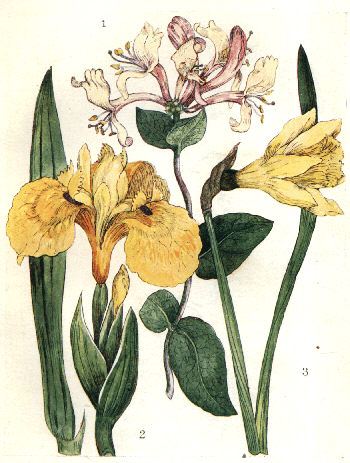 1. HONEYSUCKLE 2. YELLOW WATER IRIS
1. HONEYSUCKLE 2. YELLOW WATER IRIS The Honeysuckle grows in all parts of the country. You will find its sweet-scented flowers in thickets and woods during summer and autumn. It is a shrub with long, feeble, woody stems. These stems twist themselves round young trees and hedges, which support the plant and raise it up towards the sun.
The Honeysuckle flowers grow in loose heads at the end of the leaf-stem. They are shaped like long trumpets, and these trumpets are very narrow at the one end, and widen out at the mouth into two unequal lips. The lower lip is merely a long strap curled over at the end. But the upper lip is very much broader, and it is fringed at the edge. These beautiful flower-trumpets are yellow-pink, sometimes almost purple on the outside, and inside they are pale yellow. There are often seven to ten of these trumpets close together in one cluster, and you can see the heads of the stamens, and the long green tip of the seed-vessel coming out of the mouth of each trumpet.
After the flowers are withered, the seeds grow into clear dark crimson berries, of which the birds are very fond.
The leaves of the Honeysuckle grow opposite each other in pairs. They are blue-green in colour, are very smooth, and have a network of tiny veins all over them. Each leaf is oval, and its edges are smooth all the way round.
The Yellow Iris with its lily flowers and sword-like leaves is found in summer-time by the side of ditches, and marshes, and ponds.
In the Iris the petals and the sepals are almost the same colour. The flower has a short yellow tube which folds back at the mouth into three broad, handsome yellow sepals, beautifully marked with deep orange streaks.
Between each of these sepals stands a small pale yellow petal.
Rising from the centre of the flower are what look like other three pale yellow petals, with fringed ends which curl upward. These are really three branches of the slender column which rises from the seed-vessel, and they bend backwards over each sepal. Half hidden under each of these fringed petals, you can see the dark purple head of a stamen, closely pressed against the broad yellow sepal.
The yellow flower-tube stands above the seed-vessel. This seed-vessel becomes very large in autumn, and it bursts lengthways into three parts, showing rows of dark brown seeds tightly packed together inside.
Before the flower opens, the Iris is enclosed in a green sheath.
The leaves are sword-shaped, with long lines running from base to tip. They are smooth, and in colour they are a dim green.
The Daffodil is one of our loveliest spring flowers. It is found abundantly in woods, and in meadows and pastures in England, but in Scotland it does not grow wild, and it is doubtful whether it really does so in Ireland.
The flowers grow singly on tall stalks. Each Daffodil is enclosed in a light brown sheath, which stands erect. But when the growing flowers have burst this covering, they droop their heads.
Each flower has a short yellow tube, divided about half way down into six deep points.
These points do not fold back, they enclose a long yellow trumpet, which is beautifully scolloped round the mouth.
Inside this trumpet are six stamens with large yellow heads, and the slender stalks of these stamens cling to the sides of the yellow trumpet. There is also a short pillar rising from the fat green seed-vessel, which you can see outside the coloured petals, below the yellow tube.
In the Daffodil, the sepals and petals are the same colour.
The stalk of the Daffodil is slightly twisted, and has fine lines running up it. It rises straight from the centre of the bulb which forms the root.
The leaves are long, narrow straps with blunt points, and they are thick and juicy.
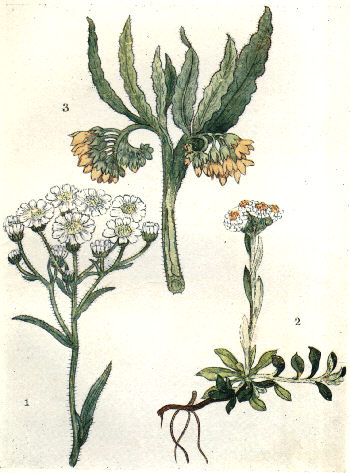
This tall, harsh-leaved plant is to be found all over the country in moist places, by the sides of streams and ditches, and by the roadside. It blooms in spring and autumn.
The flowers of the Common Comfrey are not always the same colour. Sometimes you find them pale yellow, and in other places they are a rich purple, and the buds are pink. These flowers grow in drooping clusters on short little stalks which curve in a curious serpent manner before the buds open.
The five petals joined together form a bell, which is cut into deep teeth at the edge. Within this bell, there are five stamens clinging to the sides, and from the seed-vessel, a long, slender white thread rises. You can see this white thread best after the yellow bell is withered, and the seed-vessel is left sitting in the centre of the calyx. The green calyx-cup is very shallow, with fine, sharply pointed teeth round the mouth.
The stem of the Comfrey is covered with hard, rough hairs. It has ridges running from top to bottom, and it is hollow in the middle. The leaves on the stem grow in tufts of three or four, without any stalks. They are narrow and pointed, with wavy edges, and are covered with hairs.
Many other coarse leaves rise from the root. These leaves, too, have no stalks, and they are broad and hairy.
This sturdy flower is the parent of the snow-white Bachelor's Buttons, which grow in our garden: it is a cousin of the Millfoil or Yarrow. It is common all over the country, where you find it in meadows and ditches, and by the roadside. It blooms in autumn.
The flowers resemble small daisies. You find about a dozen growing together on short stalks, near the top of the main stem.
Each daisy consists of a disc which is closely covered with greenish-white tube-flowers. The mouth of these tube-flowers is cut into points which bend outward, and coming out of the centre of each tube, you can see the yellow tip of the seed-vessel, round which the heads of the stamens are placed edge to edge like a deep collar.
Round the outer edge of the disc there is a small circle of tube-flowers, each of which has a broad white strap, and these straps are nicked at the ends.
Underneath these small daisies stands a circle of tiny green pointed leaves; these form a cup which protects the plant when it is in bud.
The stem of the Sneezewort is very sturdy. The leaves are sword-shaped, with long veins running from the base to the tip. They clasp the stem, and all round the edge they are cut into very fine teeth, like a saw.
This woolly little plant is common over most of the north country, on heaths and sandy pastures and in upland districts; but you do not find it in the south of England. It is in flower all summer.
The root of the Mountain Everlasting is like a thin brown worm lying on the surface of the ground, and from this root, long, slender brown threads go down into the ground and keep the flower steady.
The flowers resemble small woolly daisies. They grow in clusters of four or more, at the end of the main stem, and each cluster has a short, stiff stalk of its own.
These woolly daisies are made up of a great many tiny pink flower-tubes, each with a ring of fine white hairs round it. These tubes are surrounded by a double row of woolly, downy leaves which stand out like the strap-shaped rays of the daisy.
Underneath these woolly rays is a green cup, made up of a double row of narrow strap-shaped brown or green leaves, pressed close together.
The main stem rises straight and firm from the creeping root. It is closely covered with white down, and at intervals it is clasped by narrow, pointed green leaves. These leaves are dark green on the upper side, but underneath they are covered with white woolly down.
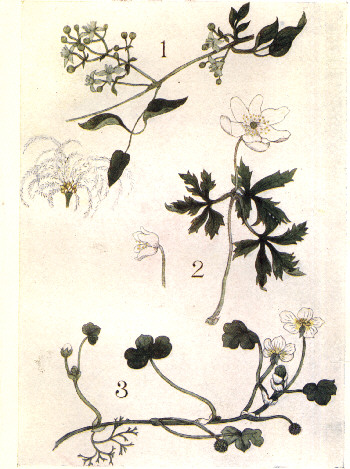 1. TRAVELLER'S JOY 2. WOOD ANEMONE
1. TRAVELLER'S JOY 2. WOOD ANEMONE You will have no difficulty in recognising this plant. It has masses of grey-green flowers, and big bunches of feathery tufts; and you will find it growing in summer right over the tops of the hedges.
There are some unusual things about this flower. It has really no petals. There are four pretty sepals of a grey-green colour, which are covered with soft white woolly down. These woolly sepals soon fall off, and within you find a big bunch of whitish green stamens. When the seeds which grow in the centre of the bunch of stamens begin to ripen, they each send out a long feathery tail. These tails wave in the air, and look like tufts of down clinging to the hedges.
The leaves are dark green above and paler green below. They grow opposite each other on the stem. Sometimes their edges are quite smooth, and sometimes they are cut like the teeth of a big saw.
The stem of the Traveller's Joy is very tough and woody. It is easily bent, and would not be able to rise from the ground were it not that there are little curly green threads called tendrils below the small leaves. These tendrils twist themselves round the stems of the hedges, and with this support the plant can climb as high as the top of the hedge.
This is one of the daintiest of our wild plants. You find the woods carpeted with it in early spring.
The flower has six delicate white sepals. These are long and rather narrow, and on the outside they are often tinged with purple or pink. The buds are usually quite pink until they open. These pink sepals form the calyx. There are no petals.
Within the pink sepals are many stamens with little yellow heads set on stems as fine as a hair, and in the centre of these stamens there is a small green knot of seeds.
The Wood Anemone has two kinds of green leaves. The flower grows on a short, smooth stalk, which rises from the centre of three soft, dark green leaves. These leaves are each divided into three parts, which are deeply cut up round the edge, and their short stalks are covered with fine hairs.
The second leaves rise on slender stalks straight from the root. They are divided very much the same as the others. If you dig up the Wood Anemone root you find that it is like a rough brown bit of stick. It creeps along underneath the ground instead of going straight down into it, and you can see that the flower and the first set of three leaves rises at a different part from the stalk which bears the other leaves.
The Water Crowfoot is really a white Buttercup, and it likes to grow in ponds or in rivers that run very slowly. The flowers are at their best in May and June.
These flowers have five glossy white petals, and each petal has a yellow patch at the foot. Behind these beautiful white petals there are five green sepals which fold back close round the flower-stalk.
Within the flower there are stamens with thick yellow heads, growing in a circle round a small green knot which holds the seed-vessels.
This Water Crowfoot has two kinds of leaves. Some grow underneath the water, and these leaves are divided into fine hairs, which are each forked at the end. The water runs very easily through these hairs.
But those leaves which are above the water are solid. They are dark green and glossy, and are nearly round. Each leaf is divided into three parts, and sometimes the edges are cut up, and often they are quite smooth.
You may sometimes find a leaf with one-half made up of hairy threads while the other half is solid.
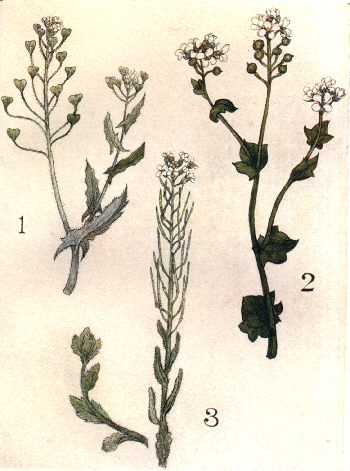
The Shepherd's Purse is a very common plant, and it is not at all attractive. It is found all summer by the roadside and in waste places.
The flowers grow close together on short stalks near the top of a spike. They are very small, with tiny white petals, and those flowers which grow lowest on the spike always come out first. The buds are in a cluster at the very tip of the spike.
After the flower is withered, the seed-vessel, which still clings to the end of the short stalk, begins to swell. It looks like a small green heart, with a hard knot in the centre. You will easily recognise the Shepherd's Purse by these seed-vessels, which are far more noticeable than the tiny white flowers.
This plant has two kinds of leaves. Those that grow close to the ground have short stalks, and they spring from the root in the form of a rosette. Each leaf is long and narrow, and the edges are deeply cut up, nearly to the centre vein of the leaf.
But the Shepherd's Purse has other leaves which grow further up the flower-stem. These are shaped like the head of an arrow, and at the bottom they clasp the stem closely.
Both kinds of leaves are usually hairy all over, and so are the stalks, but sometimes you find plants where they are quite smooth.
The Common Scurvy Grass likes to grow on muddy shores and on rocks by the seaside, where you will find its masses of white flowers all summer.
The flowers grow close together in a cluster on short stalks. Each flower has four white petals, which are sometimes tinged with purple. The four tiny sepals are tinged with purple too. And the buds which are crowded together at the end of the cluster are nearly all purple.
After the flowers are withered, the seed-vessels still cling to the end of the flower-stalks. In this plant the seed-vessels are round, like small berries, and they are greenish-brown in colour. You usually find eight or ten of these berries halfway up the stem; then there will be several white flowers still in full bloom, and at the top of the stem comes a cluster of purple buds.
The Common Scurvy Grass has two kinds of leaves. Those that spring directly from the root have long stalks. They are broad, with smooth edges, which are slightly waved, and they are thick and fleshy. The second kind of leaves has no stalks; they grow clasping the stem closely, and they are shaped like arrow-heads.
The stem of the plant is hollow, and four-sided.
This dusty-looking plant grows on dry places such as rocks, or on the top of old walls or on hedge-banks.
The flowers of the Hairy Rock Cress are white and very tiny. They have four petals, which are not at all attractive, and they grow on each side of a tall spike. After the flowers are withered, the seed-vessel, which is in the middle of each flower, grows into a long thin pod like a needle. The green needle remains at the end of the flower-stalk, and you will see ever so many of these slender green pods standing straight up round the flower-spike.
You will easily recognise this plant by these green needle pods.
The leaves of the Hairy Rock Cress are very rough, and have coarse hairs all over them. Some are long and narrow, and cling closely to the stem. Others are broader, and they have short stalks and wavy edges. Those leaves which have stalks usually grow close to the ground at the foot of the main stem.
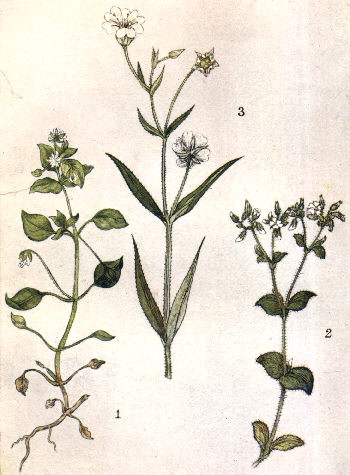
The Common Chickweed is found all over the country. It grows in fields, in waste ground, and on hedge-banks, and it is in flower from spring till autumn.
The Chickweed is a feeble, straggling plant, and it grows in an untidy mass near the ground. It is one of those plants that look very different in different places. It does not thrive well in dry, stony ground, where it looks small and dried up. But in untidy gardens where there is good soil you will find it in large bunches, with many white flowers and good-sized leaves. The canary birds like it best when there are many white flowers and seeds.
The white flowers are small, with tiny strap-shaped petals, and there are five small, green sepals with sharp points which show like the rays of a green star behind these tiny white petals.
Each flower grows at the end of a stalk which rises between the leaf and the main stem. The Chickweed leaves are oval, with smooth edges, and they grow in pairs up the stem. If you look closely at this stem you will see a line of fine hairs running down one side, and if you break this stem in two you will find that there is a green thread inside, which is more difficult to break than its soft green covering.
The Mouse-eared Chickweed is very common all over the country. It grows in dry places, on old walls or on sandy ground, and it is in flower all summer.
It is a much smaller plant than the Common Chickweed. The white flowers are very tiny, and most of them grow in clusters at the end of short stalks which branch from the main stem. But you will also find a single flower appearing between the green leaves which grow in pairs at intervals up the main stem.
These leaves are very hairy. Sometimes they are sticky, and the whole plant is usually covered with dust, and is not at all attractive.
The Mouse-eared Chickweed is not such a feeble, straggling plant as the Common Chickweed. Its stems are stronger, and they rise straight from the ground without requiring support.
You will find the Greater Stitchwort in many places. It grows in grassy meadows, in woods and in thickets, and also on rocks among the mountains; and it blooms in spring or early summer.
The Stitchwort is a tall, slender plant, and the flowers are large and very pretty. They grow singly at the end of short stalks, which usually branch in pairs again and again from the main stem, oftenest where two leaves join. These flowers have five snowy white petals, each of which has a deep notch cut in the outer edge, and there are delicate green veins all over the petals. Within the flower there are ten yellow-headed stamens. Some of these stamens are long, and some are quite short; and in the middle there is a fat green seed-vessel.
Behind these beautiful white petals grow five narrow pointed sepals, which have very little colour. These sepals are like tiny scales, slightly tinged with green, and they lie flat behind the white flower.
The stem of the Greater Stitchwort is not very strong, and it has always a line of hard, short bristles, running up each side. The leaves are like blades of grass, narrow and pointed, but they are harder than grass, and the edges curl backwards. On these edges are hard bristles, the same as those on the stems.
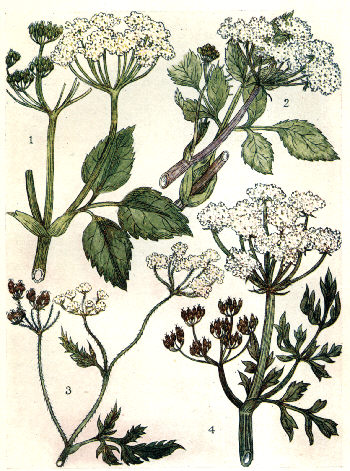
This plant grows in all parts of Britain. You find it among old ruins, and by the roadside on damp hedge-banks. It blooms in summer.
The flowers are white and very small. They grow in clusters at the end of long green spokes, like the ribs of an umbrella, and you will notice that there are no little green pointed leaves either at the back of the separate flower clusters, or at the top of the stem where all the green spokes join.
The seed-vessels are almond-shaped, with little hollows running from top to bottom, and they have two long green hairs hanging out at the top.
The stalk of the Goutweed is hollow. It is very glossy and smooth, and has many ridges.
The leaves are shaped rather like rose leaves. They are pale green and are softer than rose leaves, and there is only one other plant with umbrella spokes whose leaves are at all similar. They are quite different from the fern-like leaves of so many other umbrella plants.
Notice the broad sheath where each leaf joins the main stem.
This bushy plant is common all over Britain. It flowers in summer and autumn, and it likes to grow in damp places, especially beside streams. At first you might mistake the Wild Angelica for Goutweed, as the leaves are very similar, but there are several differences. The Wild Angelica flowers are small and white, sometimes they are tinged with lilac, and they grow in clusters at the end of green spokes like the ribs of an umbrella.
At the back of each cluster of flowers you will find three tiny pointed green leaves, and at the top of the stem where all the spokes join there are other three. This is the first difference.
The seeds of the Wild Angelica are quite a different shape from the Goutweed seeds. They are much broader, with rough ridges running up them, and they have no bristles standing up at the top. This is the second point to notice.
The Wild Angelica stalk is beautifully tinged with rich purple, not in spots as in the Common Hemlock, but all over; and it is smooth, with fine lines running up and down. This is a third point.
And lastly, the leaves grow from the end of a curious large round sheath. This sheath is pale green and is very smooth and silky. It clasps the stem, which seems to grow right through the middle of it.
In summer you will find the Upright Hedge Parsley all over the country, on hedge-banks and in waste places.
The tiny flowers are white, and are very often tinged with pink. They grow in clusters on green spokes which rise from the end of the main stem like the ribs of an umbrella. These green spokes are rough and hairy, and you will recognise this plant by these rough spokes.
There is a ring of narrow pointed green leaves at the top of the main stem where all the spokes join, and there are also little leaves at the back of each cluster of flowers.
In the Upright Hedge Parsley the seed-vessels are different from those of any of the other umbrella plants in this book. They are a dark pinky purple in colour, and are covered with short, thick bristles. At the top of each seed-vessel there are two long, thin bristles which bend over, very much like those in the Goutweed. You will always be able to recognise this plant by these bristly, purple seed-vessels.
The leaves of the Upright Hedge Parsley are dark green and hairy. They are like ferns, and have many divisions, which are cut into teeth all round the edge.
This is one of the most poisonous plants that grow in Britain. A great many accidents have been caused by cattle and human beings eating its leaves and roots.
The Hemlock Water Dropwort is common all over the country, and it is in flower most of the summer.
The flowers grow in large clusters at the end of green spokes. They are white, and they have each five stamens with large pink heads, so that from a distance the clusters look pink. There are little pointed green leaves at the back of the flower clusters as well as where the spokes join the main stem.
The seed-vessels of the Hemlock Water Dropwort are a light brown colour, with slight ridges, and they have two little points standing up at the top. You will know this plant by these seed-vessels and by the curious roots.
The stems are tall and straight, with grooves running from top to bottom. They are hollow, and so tough that they are very difficult to gather. The roots are shaped like the fingers of your hand, long, fleshy fibres that grow very thick. These poisonous roots have sometimes been mistaken for Water Parsnips. The leaves are dark green and glossy. They are not fern-like, as are those of so many of the other umbrella plants.
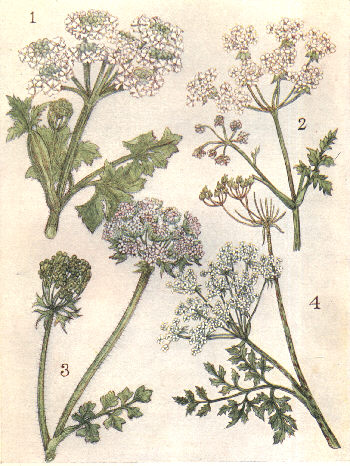 1. COW PARSNIP 2. WILD CHERVIL
1. COW PARSNIP 2. WILD CHERVILThe Cow Parsnip is a common plant which you find all over Britain in summer and autumn.
It is one of a large family of plants which have from eight to twenty stiff green spokes at the end of the stem. These spokes are all about the same length, and they stand up like the ribs of an umbrella. In late autumn, when the flowers are withered, the brown ribs still remain on the plant.
Each green rib carries a flat bouquet of flowers. In the centre of this bouquet there are green buds, and all round the buds is a ring of small white flowers.
The stem of the plant is rough and hairy, and it is deeply grooved. The inside is hollow, and when the winter comes, small insects creep into these hollow stems for shelter.
The Cow Parsnip has large, rough leaves. These are covered with coarse hairs, and they always look dusty and shabby. You will notice curious green knobs which appear close to the stem.
These knobs are covered with a thin green sheath, and the flower-bud, with all its spokes still closed, is inside.
This bud grows bigger and bigger until it bursts the sheath. Then the flowers unfold, leaving the green covering still growing from the stem, with a curious green leaf coming out of the end.
This is a slender plant which is very common on hedge-banks and in open woods. It blooms all spring and summer.
The flowers are white, and they grow in clusters at the end of green spokes which look like the ribs of an umbrella. Notice that there is no ring of feathery green leaves where these spokes join the main stem. Before the flowers open, these green spokes bend downward.
There is a ring of tiny pointed leaves at the back of each cluster of flowers. These tiny leaves are tinged with pink, and when the flowers are fully opened, they fold back close to the main stem.
In the centre of each flower there is a long, thin seed-vessel. After all the white petals have fallen off, these seed-vessels grow into fat green beaks, each on a short stalk, and with two green points at the end.
The Wild Chervil is easily recognised by these clusters of green beak-like seed-vessels.
The leaves of the Wild Chervil are pale green, with fern-like divisions. Wherever they join the main stem there is a broad sheath.
The Wild Chervil has a stem which is deeply grooved. This stem is not spotted, but you will find another Chervil, the Rough Chervil, which is very like this one.
In it the stem is covered with purple blotches, and the leaves are blunter and less fern-like.
The Sea Carrot is common in many parts of Britain, where it blooms on the seashore all summer and autumn.
It belongs to the large family of plants that carry their flowers on green spokes like the ribs of an umbrella, and as these flowers are very confusing, you must notice the differences carefully.
The flowers of the Sea Carrot are usually small and white, though sometimes they have a pinky tinge. They grow in masses at the end of the green spokes. Before the flowers are fully out, these spokes stand straight up in the air, very close together, with the clusters of flower-buds all turned inwards.
But when the buds begin to open, these green spokes fold down so as to give the flowers room to look up towards the sun.
You will always know the Sea Carrot by the curious way the spokes stand close together until the flowers open.
At the top of the main stem, where all the spokes join, there is a circle of feathery green leaves. These feathery leaves each end in three points, and they have a special name which you will learn some day.
The leaves of the Sea Carrot are like fine soft ferns. They are so pretty that people use them for decoration among flowers.
The Hemlock is a common plant which is found all summer in waste places by the roadside and in open woods. It is poisonous, and you should look at it carefully, so as to know and avoid it.
The flowers grow in clusters at the end of green spokes like the ribs of an umbrella, which do not droop before they are fully out.
At the back of each little cluster of flowers you find three tiny pointed green leaves which are all turned to one side. This is the first point by which to recognise the Common Hemlock.
The stem is covered with purple blotches, and there is only one other umbrella plant which has a spotted stem.
The Common Hemlock stem is not hairy. It is smooth, with green ridges running up it, and it is not swollen where the leaves branch from it. This is the second point to notice.
The third point, and a very important one, is the shape of the seed-vessels. In the Wild Chervil these are little green beaks, rather long and thin, standing up in clusters. But in the Common Hemlock the seed-vessels are short and round; they are like two small apples stuck close together, and each has a little green swelling at the top. These seed-vessels are covered all over with rough ridges.
The leaves are fern-like, and resemble many of the other umbrella plants.
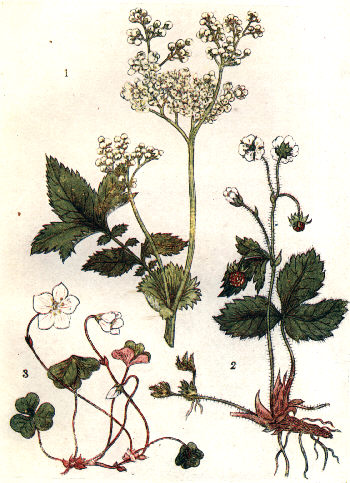 1. MEADOW SWEET. 2. WILD STRAWBERRY.
1. MEADOW SWEET. 2. WILD STRAWBERRY. The Meadow Sweet grows abundantly all summer by the side of streams and in damp places. Many a time its delightful scent has tempted us to gather it in handfuls.
The flowers are creamy white, and are very small, with a great many yellow stamens in the centre. They grow in large clusters on short branching stalks, and the buds look like tiny ivory balls set in small green cups. You often see two or more branched stalks which shoot high above the mass of open flowers, bearing a great many closed buds. When the flowers are withered, the five green sepals fold back against the stem.
The green leaves of the Meadow Sweet are dark and rough above, but underneath they are covered with white down. They have a central leaf-stalk, and on each side of the stalk grow a pair of big leaflets and a pair of small leaflets alternately. Sometimes two pairs of very small leaflets may come together, and at the end of the stalk you always find one big leaflet which has several points.
The stem of this plant is hard, and it has lines running from end to end. Where the flower-stalk and the leaf-stalk join this stem, you find a curious green sheath, which seems to clasp them all together, and this sheath has sharply cut edges.
The Wild Strawberry is common all over Britain. In early summer you find it in woods and on shady hedge-banks. This pretty plant is related to the Wild Rose. It has dainty little flowers, with five small white petals, and behind these petals is a star of ten green pointed sepals. Five of these sepals have large points which show in between the white petals as you look down into the flowers, and the five which are smaller you can only see at the back of the flower.
The stamens grow in a ring close round the seed-vessel, and as they are joined to the sepals, they do not fall off when the white petals wither.
As the fruit ripens, the seed-vessel swells into a bright red berry, and you can see the tiny yellow seeds clinging all over this juicy berry.
The green leaves of the Wild Strawberry are beautiful. They are dark and crinkled, with soft hairs on the edges, and these edges are cut into large teeth. There are always three leaflets at the end of each stalk.
This Strawberry plant sends out long green shoots which lie close to the ground. Wherever a tuft of leaves rises from one of these shoots, a little bunch of white roots grows down into the ground, and these help to keep the plant steady.
The dainty Wood Sorrel is common all over the country. It grows in damp woods and in shady places, and it blooms in spring.
The flowers grow singly at the end of slender pink stalks. They are large, and have five beautiful white petals, slightly tinged with pink. These petals are covered all over with fine veins, and when the sun shines on the plant they open out almost flat.
If you look closely at the bundle of yellow stamens in the centre of the flower, you will find that five are long and five are short.
Behind the white petals there is a tiny green cup, which is made up of five sepals joined together. The mouth of this cup is edged with five sharp points.
The leaves of the Wood Sorrel are very pretty. Each leaf has a slender pink stalk which springs straight from the root, and every leaf is divided into three delicate leaflets, which are pale green above, and a delicate pale pink below. These leaflets are heart-shaped, and before they have fully opened, they droop close to the stem.
If you taste one of the Wood Sorrel leaves, you will find it is bitter but not unpleasant.
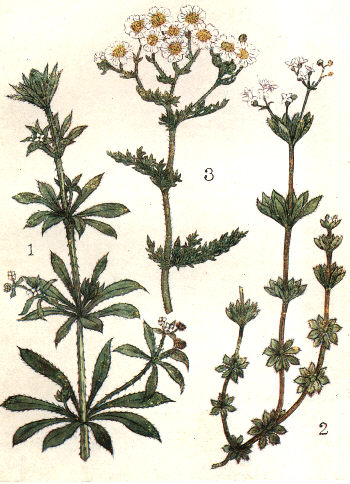 1. GOOSEGRASS OR CLEAVERS 2. WOODRUFF
1. GOOSEGRASS OR CLEAVERS 2. WOODRUFF This clinging plant is common everywhere. It grows abundantly on every hedge-bank, and it is in bloom all summer and autumn.
The flowers are so small that you scarcely notice them. Each flower has four tiny white petals, and four yellow-headed stamens. Behind the flower there is a ring of narrow pointed pale green leaves.
When the white petals fall off, you see two pale olive or dull purple seeds, shaped like little balls. These balls always grow in pairs, and they are covered with sharp, prickly hooks, which cling to everything they touch. You find them clinging to your clothes, and they get caught in the hair of a dog's back, and you see them sticking to the wool of the sheep who nibble at the hedge-banks.
The square stem of the Goosegrass is rather weak. It, too, has hooks on its four sides, and these hooks catch hold of stronger plants in the hedge-bank, and so help the Goosegrass to rise well above the ground.
The leaves are long and narrow, and they have little hooks along the edge. They grow in a circle of eight round the square stem, with a short space between each circle. You will notice that the stalks which bear the tiny white flowers spring from the same part of the main stem as the leaf circles.
The sweet-smelling Woodruff is common all over the country, and when dried its perfume is like new-mown hay. It grows in woods and on shady hedge-banks, and it flowers in early summer.
The flowers are small and white, with four petals which stand round the mouth of a tiny tube. Inside this tube are four yellow-headed stamens, and there is a small green sepal-cup in which the white tube stands. The flowers grow in clusters at the end of the main stem. They do not rise from each circle of leaves as in the Goosegrass. The tiny seeds are black, and each seed is thickly covered with soft bristles, which are hooked at the end.
The ridged stem of the Woodruff is often a dull red colour. This stem is very feeble, so the Woodruff is usually found lying in a tangle along the ground. It has not so many hooks as the Goosegrass with which to catch hold of other plants, and so raise itself.
The leaves grow about an inch apart on the stem, in beautiful circles. In each circle there are eight narrow leaves which are pointed at the end. The circles nearest the foot of the stem lie flat open like a rosette, but those that are further up are usually half closed, with all their points standing upwards.
The Yarrow or Millfoil is a very common plant all over Britain. It grows on waste ground and in the corners of fields, and it is in flower in late summer and autumn.
It is one of the daisy plants, and you must look at it carefully. The flowers grow in clusters, three or four together, at the end of stalks which branch from the main stem. They are white, and look like tiny daisies. You must pick one of them gently to pieces, and then you will find that each daisy is really made up of a great many small flowers crowded together on a disc. The outer flowers consist of a white tube, with one long white strap, and there is a row of these white straps standing out like a frill round the yellow centre. Inside this white border there are a great many tiny yellow tube flowers, with five points at the mouth of each tube, but these you will not see without a microscope.
Outside this mass of flowers grows a ring of small green leaves, which are closely packed together and are very woolly.
The stem of the Yarrow is stiff and smooth and is slightly tinged with red. The leaves are long and narrow, and each leaf is made up of many tiny pairs of leaflets placed opposite each other on the stem. Each leaflet is cut up into many divisions, so that the whole leaf is light and feathery like a small fern.
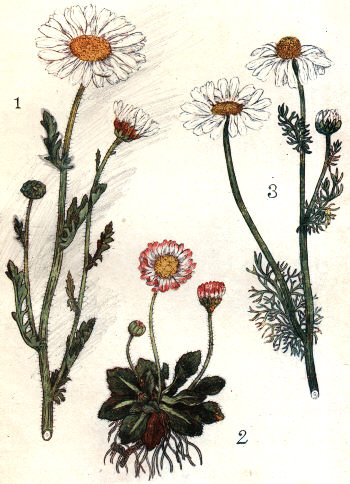 1. OX-EYE DAISY 2. DAISY
1. OX-EYE DAISY 2. DAISY The handsome Ox-eye Daisy is common all over Britain. You find it in flower from summer to the end of autumn.
It is a plant with a tall, stiff stem that has ridges running from top to bottom.
Notice how different its leaves are from those of the small Daisy, though both plants belong to the same family.
The flowers in the Ox-eye Daisy are very large. The yellow tube flowers in the centre are crowded together on a flat disc, and outside this disc there is a double ring of tiny white tubes, each of which has one broad white strap. These straps form the beautiful border to the flower.
At the top of the green flower-stalk there is a double ring of narrow green pointed leaves. When the flowers are in bud they look like thick green buttons, with a yellow spot in the middle, as these green leaves are tightly folded in a circle round the flat yellow centre.
The leaves are straggling and very poor-looking for such a handsome plant. They are feather-shaped, with the edges deeply cut up into many blunt points. They have no stalks of their own, but spring from the main stem.
This well-known plant is to be found all over Britain. It is in flower from spring to late autumn, and I think it is the first flower little children learn to recognise.
But it is often a long time before they get to know anything more about the Daisy than its name, and yet it is an interesting flower, as well as a pretty one.
If you gather a Daisy, and then gently pick it to pieces, you find that it is made up of a great many tiny little flowers crowded together on a pear-shaped centre. These tiny flowers are of two kinds; those in the centre are yellow and are shaped like little tubes, each of which is edged with five points. But in the outer row of flowers, one of the five points has grown into a long white strap, which is tinged with pink and red at the tip.
These pretty white straps are arranged in a double frill round the yellow centre.
At the end of the flower-stalk there is a thick ring of small green pointed leaves, and these, as well as the stalks, are slightly hairy.
The Daisy leaves grow in a rosette close to the ground. They are oval, and each leaf has hairs all over it and round the edges.
This daisy plant is very common too. It grows all over Britain, and is in flower from June till October.
It is not such a stiff, handsome plant as the Ox-eye Daisy, but much more branched and bushy, and it often grows close to the ground. The stalks are tougher, and they are quite smooth, with fine ridges running up them.
The flower-heads are made up in the same way as those of the other daisy plants. You find a mass of tiny yellow tubes in the centre, and forming a border round this yellow centre is an outer ring of flowers, each with one large white strap.
When the Mayweed begins to wither, these white straps droop towards the stalk, and the yellow centre, instead of remaining nearly flat, becomes the shape of a thimble. You will find many of these yellow thimbles on the plant, after all the white straps are gone.
The tips of the green leaves, which grow in a double ring behind the flowers, are often tinged with pink.
The leaves of the Scentless Mayweed are like many leaves that grow in running water. They are divided into a tangle of fine hair-like points, which spring directly from the main stem without any stalk.
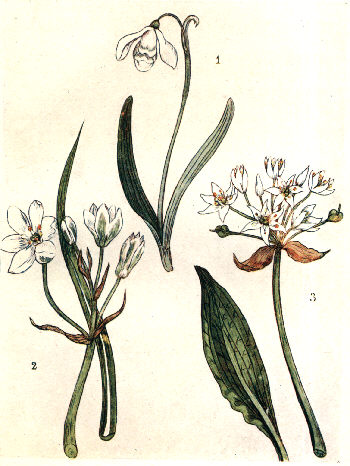 1. SNOWDROP 2. COMMON STAR OF BETHLEHEM
1. SNOWDROP 2. COMMON STAR OF BETHLEHEM The modest Snowdrop, with its graceful, drooping head, grows abundantly all spring in meadows and pastures and orchards in England and Scotland. It is not so common in Ireland.
The flower is enclosed in a grey sheath, edged with bright green lines. After the flower bursts out of the sheath, it droops from the end of a slender flower-stalk. Each flower has six white petals; the three outer petals are boat-shaped towards the tips, and there are three shorter petals which are not curved. These straight petals have a notch cut in the upper edge, and there is a bright green wavy stain just below this notch.
Inside these dainty white petals are six yellow-headed stamens with scarcely any stalks. These stamens stand on the flat round top of the seed-vessel, and in the centre rises its short, pointed pillar.
Notice that the oval green seed-vessel is outside the circle of white petals, at the top of the slender flower-stalk.
A single pair of leaves rise from the Snowdrop root, with the flower-stalk between them. These leaves look like short straps with blunt points. They are bluey green in colour, and have deep grooves running from base to tip.
This beautiful starry plant is found in many places in England and in a few in Scotland, but not in Ireland. It grows in meadows and pastures and orchards in early summer.
The flowers grow singly on long stalks which branch near the top of the main stem. There is always a withered-looking brown leaf at the base of each flower-stalk.
The flowers have six large white petals, which are pointed at the tips. The back of each petal is stained with bright green, except round the edge, where it remains white.
There are six yellow-headed stamens clinging to the base of the white petals. These stamens stand up in a circle round a fat green seed-vessel which sits in the centre of the white petals. This seed-vessel has a tiny pointed column in the middle.
The leaves of the Star of Bethlehem are very narrow. From the middle each leaf tapers to a long point. These leaves are deeply channelled, and they have a broad white stripe running down the centre.
This unpleasant-smelling plant is common all over the country, except in the North of Scotland. It grows in woods and copses and on hedge-banks, and it blooms in early summer.
Each flower grows on a short stalk, in a loose cluster at the end of a stout juicy stem. When in bud these flowers are all enclosed in a brown sheath, which bursts open in two pieces as soon as the flowers are ready to expand.
Each flower has six narrow white pointed petals, opening flat out like a star. There is a short yellow-headed stamen clinging to each of these white petals. In the centre of the flower, among the white petals, is a green seed-vessel, which is divided into three small oval balls. A slender pillar rises from amongst these small seed-balls.
There are no sepals in this flower.
The leaves of the starry-white Ransoms are not unlike those of the Lily of the Valley. They have long lines running from base to tip, and are a delicate pale-green in colour.
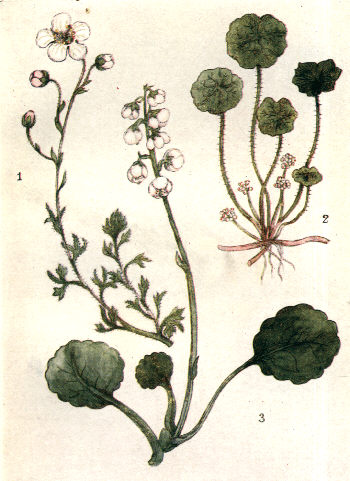 1. MOSSY SAXIFRAGE. 2. MARSH PENNYWORT.
1. MOSSY SAXIFRAGE. 2. MARSH PENNYWORT. In all parts of the country this slender, graceful plant is abundant. You will find it growing on damp banks and on the mountain side, and it blooms throughout the summer.
The flowers are cup-shaped, and they grow singly on short stalks which branch from the main stem near the top. Each flower has five white petals streaked with fine veins.
Within the petal-cup there is a ring of ten stamens with yellow heads, and in the centre of the flower you can see a green seed-vessel like a small pear, with two wavy points coming out of the top.
Behind the white petals you find a tiny green calyx-cup, made up of five little sepals. These sepals are joined together at the bottom, but round the mouth of the cup the five points stand up separately.
The reddish-green stems are slender and wiry. They have single, little leaves growing up them, with a short space in between each leaf.
Only some of these stems have flowers at the top. Others end in a tuft of leaves, and never bear any flowers. These leafy stems are clothed with leaves all the way to the tip, and each leaf is very small and narrow. At the end the leaf is divided into three small fingers, and these fingers, as well as the stem, are covered with dark hairs.
This water-loving plant is very common all over the country in marshes and bogs and by the sides of ditches. It blooms in summer.
The plant is easily recognised by its round leaves. These have wavy edges, and fine green veins running from the centre of the leaf to the edge.
The stalk is fastened exactly underneath the centre of the leaf, and it is soft and juicy and covered with fine hairs.
The flowers of the Pennywort are greenish-white, tinged with red. These flowers grow in little clusters of three or four together at the end of short stalks which spring from the root, close beside the leaf-stalk. But these flower-stalks are so short, and the flowers are so small, you recognise the round leaves long before you discover that there are any flowers.
The Pennywort is one of those plants with a creeping stem, which lies along the surface of the ground. The stem is a delicate, pale pink, and wherever a bunch of flowers and leaves rises, you find a tuft of white, hair-like roots growing down into the mud.
It is a great delight to discover this dainty plant. It is not very common, but in summer and autumn you find it blooming on heaths in many parts of the country.
The Wintergreen flowers are not unlike Lily-of-the-Valley. They are delicate, creamy white bells, which hang from short drooping stalks near the top of a slender stem.
These bells have five ivory petals slightly tinged with pink, which form a dainty fairy cup.
Within the cup there is a ring of ten stamens with heavy yellow-heads, clustered round the tip of the green seed-vessel. This green tip rises in the centre, like a slender pillar, a good way above the stamens.
Behind the ivory cup is a green star, with five points. These points are the sepals. Notice that wherever a flower-stalk joins the main stem a tiny pointed green leaf appears.
The soft juicy stem is twisted near the top and is four-sided. It grows straight from the root.
The dark glossy leaves of the Wintergreen are spoon-shaped, with wavy edges. They spring from the ground with very short stalks, and they remain on the plant all winter.
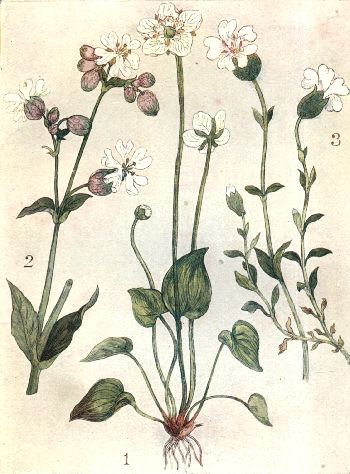
This slender plant grows in bogs and damp places all over Britain and blooms in autumn.
It has large white flowers, which grow singly at the end of tall green stalks. These stalks are square and slightly twisted.
Each flower has five creamy-white petals, covered with delicate veins. Inside this ring of petals, lying at the bottom, are five curious scales, like tiny hands. The hands have each ten fingers, tipped with yellow dots, so you may count fifty dots altogether. On the scales are glands which hold honey. This, you may be sure, the bees very soon find out.
In the centre of the flower is a round pale green seed-vessel, and in between the scales with the tiny yellow dots lie five fat stamens with heavy yellow-heads.
The Grass of Parnassus has also five green sepals, whose tips you can see appearing in between each of the five white petals, as you look down into the flower.
Most of the green leaves of this plant grow from the root. They are oval, with smooth edges, and each leaf has a stalk of its own.
But often you will find a single leaf clasping the flower-stalk half way up its stem, and this leaf has no stalk of its own.
The Common Bladder Campion is to be found all summer by the edge of fields and pastures.
It is a tall, slender plant, with white flowers which grow each on a thin short stalk, two or three close together at the end of a smooth stem.
The flowers have five petals, and each petal has V-shaped notches cut in the outer edge. The lower part of the petals is hidden from sight in the calyx-cup.
The five sepals which form this calyx-cup are joined together, and they are swollen like a bladder. This bladder is covered with a fine network of reddish veins, and has five teeth round its mouth.
You will easily recognise the Common Bladder Campion by this curious calyx.
In this white Bladder Campion the stamens and the seed-vessel are found in the same flower, and you can always see the forked tip of the seed-vessel, rising among the dark green heads of the stamens.
The leaves of the Common Bladder Campion are smooth and shiny. They grow opposite each other in pairs, and wherever a pair joins the main stem, the stem is swollen like the joint of a finger.
The Sea Campion grows by the seashore, by the side of mountain streams, or on wet rocks among the hills.
It blooms all summer, and although it is really a smaller plant than the Common White Campion, the flowers are larger.
These flowers have five white petals, each with a V-shaped notch in the outer edge. Half way down these petals there is a white-fringed scale. These scales stand up like a crown round the inside of the flower.
The calyx is swollen like a bladder, and is covered with fine veins, the same as in the Common Campion. Round the mouth it has five sharp teeth.
In this plant the flowers do not grow in groups of two or three. Each flower appears singly at the end of a slender stalk, and there are several pairs of small leaves a good way below the flower.
These leaves are slightly thick and juicy. They grow so close together on the ground that it looks as if it were covered with a green mat.
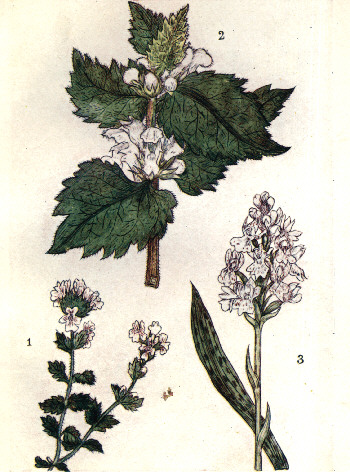
This humble little plant is to be found everywhere on heaths and meadows and pastures. It blooms plentifully in summer and autumn. The flowers of the Eyebright grow in clusters of four to six at the end of the main stem. They are white, or pale lilac streaked with pink, and they are small and unattractive. The petals are joined together into a tube, with two lips at the mouth. The upper lip has two divisions, and the lower lip is cut up into three. They appear to be five unequal petals standing round the mouth of the tube.
Inside the tube are four purple-headed stamens, two long and two short. You can see them appearing at the mouth of the tube, also the slender white point which rises from the seed-vessel.
The calyx is a green cup with four deeply pointed teeth at the mouth. The tube of the flower goes down into the cup, and the five unequal petals stand round its mouth.
The Eyebright stem varies much in height. Sometimes you find it only about two inches from the ground, and in other places it has straggled eighteen inches high. These stems are very hairy.
The leaves grow opposite each other in pairs up the stem. They have no stalks, and the edges are cut all round into blunt teeth. They are rather hairy leaves, and are dark green and crinkled. In shape they are oval with a blunt point at the end.
The White Dead Nettle is fairly common everywhere except in the North of Scotland. You find it in waste places, by the roadside, and on ditch banks, and it blooms from spring to autumn.
This is a much more attractive plant than the Stinging Nettle we have all learned to avoid.
The flowers grow in beautiful whorls or circles round the stem. In this plant the flowers are snowy white, tinged with green, but in other Dead Nettles you find them rose pink or deep purple.
There are often as many as eighteen flowers on one whorl. The flower petals are joined together into a tube which stands in a shallow calyx-cup, edged with five very long, sharp teeth. The mouth of the white flower-tube is cut very irregularly. The upper part bends over like a hood, and underneath this hood are hidden the four long stamens. The lower part of the flower-tube hangs down like a tongue, and it is fringed and rounded at the end. Amongst the stamens you see the slender forked point which rises from the seed-vessel.
The leaves of the White Dead Nettle are very similar in shape to those of the Stinging Nettle; but they are a paler shade of green. They grow in pairs close to the stem, with a good space in between each pair, and the ring of stalkless flowers clusters round the stem beside them.
This Orchis is common all over the country, where it grows in damp woods, on chalky banks, and in meadows and pastures.
You find it in summer.
The leaves are stained with purplish-black blotches as in the early Purple Orchis, but they are narrower and taper more to a point. Notice the small leaves which cling at intervals to the flower-stalk all the way up.
The flowers grow in a dense cone-shaped head at the top of the flower-stalk. The petals are pale lilac or nearly white, and are spotted or streaked with purple. They are curiously shaped. The broad petal, which folds back like a hanging lip, is deeply waved round the edge, and behind it there is a long lilac spur.
Two petals stand erect, and form a hood which covers the stamens and the slender column of the seed-vessel.
There are also three small lilac or white sepals which you will scarcely be able to distinguish from the petals.
The flower sits at the top of what looks like a swollen stalk, but is really the seed-vessel.
Where this stalk-like seed-vessel joins the main stem there is always a tiny purple or green leaflet.
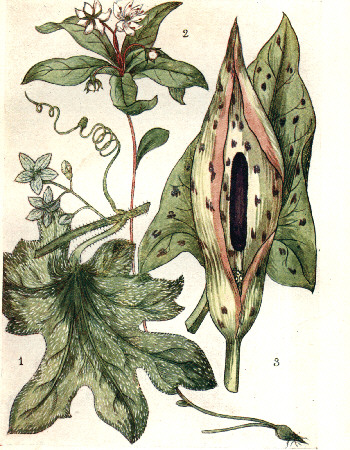
The Red-Berried Bryony is very common in the South of England, where it climbs over the hedges and grows among the thickets. But it does not grow wild in the North. It is in flower all summer and autumn.
The stems of this plant are soft and easily broken, and they have not enough strength to keep the leaves and flowers upright. But at the bottom of each leaf-stalk, there are long curly green tendrils, and with these the Bryony catches hold of some stronger plant, which helps to support it.
The flowers are greenish-white in colour, and they grow in loose heads which spring from between the leaf-stalk and the stem.
These flowers have five separate greenish-white petals covered with a fine network of veins and with many transparent hairs.
At the back of the petals sits a green calyx-cup edged with five pointed teeth.
When the flowers are withered they are followed by groups of beautiful dark red berries.
The Red Bryony leaves are very large, and are shaped like a hand with five blunt fingers. The green colour is pale and bright, and each leaf is covered with short white hairs.
It is delightful to find the Chickweed Wintergreen as it is rather a rare plant. It grows in fir woods and on heaths in hilly districts, and it blooms all summer. There is no other plant at all like this Wintergreen, so you will have no difficulty in recognising it.
The stem is very delicate and wiry, and at the end it bears a spreading rosette of six long pointed leaves. These leaves are smooth and shiny: in autumn they are often tinged with purple.
You may find one or two solitary leaves lower down on the stem; if so, these leaves are quite small, and they are rounded at the ends.
The flowers look like white stars. They have five or seven long narrow petals with pointed tips. These petals lie open in a circle, and you can see five or seven thread-like stamens with tiny pink heads rising in the centre, round a small green seed-vessel.
The flower-stalks grow from the centre of the green leaf rosette. Each flower has a delicate pink stalk of its own, and you may find three or four stalks springing from the same place. But more often the flower is solitary.
This is one of our most curious wild plants. It is common in England and Ireland, but rare in Scotland. It grows on hedge banks and in open woods, and blooms in late spring and early summer.
The large glossy leaves are arrow-shaped, and they are covered all over with dark purple blotches.
From amongst them rises a pale green twisted sheath, which is completely closed when in bud. Like the leaves, it is spotted all over with purple blotches, and the edges are stained a pale yellow-brown.
Inside this sheath rises a tall narrow purple cone, on a stout green stalk. Fastened round this green stalk are three curious collars.
First comes a collar of tiny green pear-shaped glands, of which nobody knows the use. Then comes a purple collar made up of stamen heads without any stalks.
And a little way below these there is a deep band of round green seed-vessels like small beads. These are hidden in the lower part of the green sheath; but in autumn they grow much larger, and soon burst open the covering sheath. Then they turn into beautiful scarlet berries. These berries are very poisonous.
The root of the Cuckoopint is a rough brown knob with many white rootlets hanging from it.
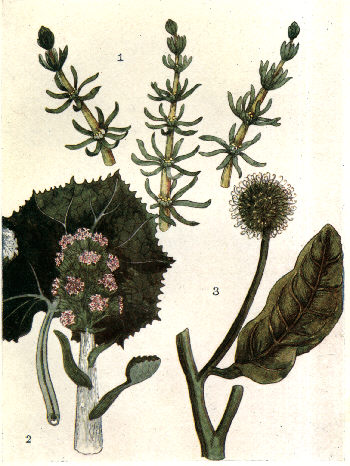 1. COMMON MARE'S TAIL 2. COMMON BUTTERBUR
1. COMMON MARE'S TAIL 2. COMMON BUTTERBUR This strange-looking plant grows in many parts of the country, and its spikes are found during summer in ponds and ditches. The flowers are so tiny that you may scarcely notice them. They grow in a circle close round the main stem where the leaves join it, and they are greenish in colour. These flowers have no petals, and all you can see is a small green ball with a yellow dot on the top of it.
The leaves of the Common Mare's Tail grow in circles up the stem at short distances apart. They are very narrow and pointed, exactly like short green straps, and you find from six to twelve of these strap-leaves in the same circle.
The Common Butterbur grows in wet places, especially beside streams. It is not found in the North of Scotland, but is common in the South country. The flowers appear very early in spring, before the leaves, and they are nearly withered by the time the leaves are at their best.
The flowers grow closely crowded together in cone-shaped heads, near the top of a thick fleshy stalk. These flowers are made up of tiny pink tubes with toothed edges, and there is a row of long-headed pink stamens clinging to the inside of each tiny tube. Outside the head of flowers there is a thick bundle of narrow green pointed leaves, and each little bundle of green leaves and pink tubes has a short stalk of its own.
You will notice the narrow green leaves which grow singly up this main stem. Sometimes these leaves become much broader at the tips, and when this is the case these leaf-tips are dark green and have toothed edges.
The root leaves of the Butterbur are very large. They are roughly heart-shaped with sharply cut teeth round the edge. Each leaf is dark green and smooth above, but underneath it is woolly, and the short stalk on which it grows is hollow.
The Greater Burdock grows in waste places by the roadside and on the borders of fields. It is fairly common all over Britain and flowers in autumn.
The Burdock is a low-growing bushy plant with strong stems. Growing close to the ground it has large coarse leaves not unlike rhubarb leaves. They are dark green, very wrinkled, and with slightly waved edges.
The leaves which grow on the flower-stems are much smaller, and are long and rather narrow.
The flowers are scarcely seen. They are made up of small rose-coloured and purple tubes, which are crowded close together at the end of stout round stalks. But these small flowers are completely surrounded by a ball of green bristles, so that you require to pull the bristles apart and look into the top of the green ball if you wish to find the flowers.
Each of the bristles on this green ball ends in a tiny hook, and with these hooks they cling to whatever they touch. You often see these prickly balls sticking to the wool on a sheep's back. If you throw one at a companion it will hang to his clothes by its sharp little hooks.
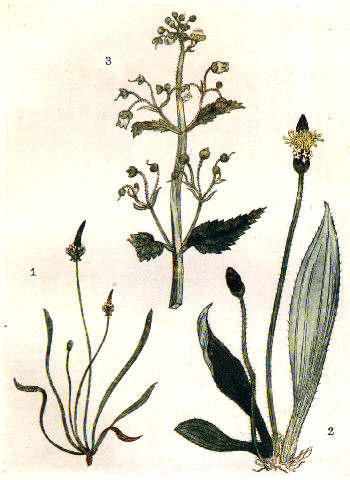 1. MOUSE TAIL. 2. RIBWORT PLANTAIN.
1. MOUSE TAIL. 2. RIBWORT PLANTAIN. This little plant grows plentifully in the East of England, but it is not found all over Britain. It flowers in summer.
You will easily recognise it by the curious way the seed-vessels grow. You remember in the Buttercup (Plate I.) there was a little hard knot of seed-vessels like a green raspberry in the centre of the ring of stamens?
The Mouse-Tail is a cousin of the Buttercup, but the seed-vessels grow on a long pointed spike which shoots up in the middle of the flower, and is just like a mouse's tail.
Each flower has five yellowish-green petals, shaped like pale yellow tubes, with a lip at the top. There are five long, narrow, yellow-green sepals, with little spurs at the bottom. And there is also a ring of stamens with yellow heads which stand straight up round the foot of the Mouse's Tail.
The leaves are long and narrow, with a line down the centre. They are rather thick leaves, and they all grow in a tuft from the root.
Is there any child that has not played at 'Soldiers' or at 'Lords and Ladies,' with the flower-heads of the Ribwort Plantain? It is common everywhere, and flowers from spring to autumn.
The narrow pointed leaves grow in a circle straight from the root. They are dark green on one side, and silvery green on the other, and have long 'ribs' running from the bottom to the top. From these 'ribs' the plant gets its name of 'Ribwort.'
The flowers are closely crowded together in brown, cone-shaped heads. Each flower consists of a narrow white tube, with four graceful yellow points folded back at the mouth.
The large yellow heads of the stamens stand up beyond the mouth of this tube, but you can scarcely see the tip of the seed-vessel which is hidden inside.
When the flowers are fully out, you do not notice the white tubes; all you see is a big cluster of fuzzy yellow-headed stamens.
There are four small green sepals at the bottom of the flower-tube, and these sepals are often stained with brown blotches.
The stems are ribbed all the way up and are covered with short hairs. They are juicy and very easily broken.
This uninteresting plant is abundant everywhere. It is found in damp, shady places by the side of ditches, and it is at its best in summer and autumn.
At first you scarcely notice the flowers. They are small, dull green bells stained with brown, and are not at all attractive. But when you examine them, you find that the mouth of each bell is prettily waved all round the edge, and inside there are two long stamens and two short ones, as well as a fat green seed-vessel, with a curly point standing up in the middle.
There is a green calyx-cup with five teeth at the mouth, and as the small green bell soon withers and falls off, you oftenest notice this calyx-cup with a green seed-vessel sitting in the centre.
The tiny flower-bells grow in loose clusters, which spring from between the leaf and the main stem.
The Knotty Figwort is a tall and stout plant, with a four-sided stem which is curiously twisted.
Be sure to pull up the root, and you will find it covered with small bulbs or knots. From these knots the plant gets its name.
The leaves near the foot of the Knotty Figwort stem are large and broadly oval, with short stalks. But those that grow further up the stem are narrower and more pointed, and they all have the edges cut like the teeth of a saw.
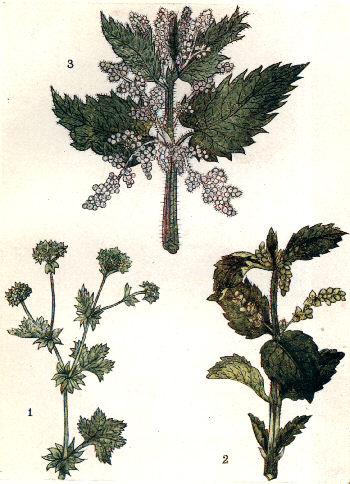 1. LADY'S MANTLE 2. DOG'S MERCURY.
1. LADY'S MANTLE 2. DOG'S MERCURY. The Lady's Mantle is a curious little plant and is common everywhere in summer. The beautifully shaped green leaves at once attract you, but the flowers are so small that you scarcely notice them. They are crowded into clusters at the end of short stalks, which branch many times from the main stem. These flowers have no petals. If you look at them very closely, you find that they have eight green sepals, which lie flat open when the flower is in bloom. These sepals are all pointed, and vary in size. The four which are utmost are smaller than the sepals which form the inner circle.
In the middle of these green sepals there is a yellow ring, and in the centre of this ring sits the tiny seed-vessel, sunk almost out of sight. There are four stamens, each of which stands out separately from this yellow ring.
The root-leaves of the Lady's Mantle are rounded, and they are covered with a fine network of veins. Each leaf looks as if it had been folded into five or seven folds, and each fold is divided round the edge into scollops. The edge of these scollops is cut into sharp teeth. Sometimes you find a big diamond dew-drop lying in the folds of the Lady's Mantle leaf.
You will also notice a frill of tiny pointed green leaves clasping the main stem wherever it forks.
The Dog's Mercury grows abundantly in England and Scotland but is rare in Ireland. You find it during early spring in woods and shady places and thickets.
This is one of our green flowers. It has no beautiful coloured petals to attract the bees or insects.
The Dog's Mercury is a bushy, upright plant, with a stout, four-sided green stem, closely covered with pretty leaves.
These leaves grow in pairs, on alternate sides of the stem: they are oval, and slightly hairy, and the edges are cut all round into sharp teeth.
Where each leaf joins the stem a flower-stalk rises, and in the Dog's Mercury there are two kinds of flowers. On one stalk you find groups of small flowers clustered at close intervals round the stalk. Each of these flowers has three broadly pointed green sepals, which curl slightly at the tips. In the centre of these sepals rises a large bunch of eight to sixteen yellow-headed stamens. In these flowers there are no petals, and no seed-vessel.
But you will find different flowers on another plant. These flowers have also three green sepals, and are without petals. But in the centre lie two hairy green seed-vessels, like small peas joined together, and on the top of these seed-vessels are two tiny green horns.
What child does not know the Common Stinging Nettle? We have all learned to avoid it after having felt its sting.
You find this Nettle everywhere in late summer and autumn.
It has a four-sided stem, which is rough with bristly hairs. The leaves grow opposite each other in pairs with a good space between each pair. They are dark green and rather coarse, and are covered with a network of veins and with many stinging hairs.
Close to the stalk the leaves are heart-shaped, but the tips are sharply pointed and the edges are deeply toothed all round.
The flowers of the Common Nettle grow on slender stalks which rise between the leaf and the main stem. These flowers are green, and they are very small and unattractive.
On one flower you find four green sepals and four yellow-headed stamens, but there are no petals and no seed-vessel.
In another flower there is a fat green seed-vessel, with four sepals round it.
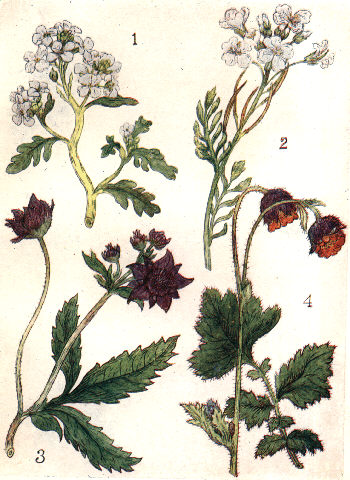
The Purple Sea-Rocket grows abundantly all summer on most of our seashores. It is a bushy plant with many branches, and you will recognise it by its thick and fleshy green leaves. The flowers are a pale lilac colour, like those of the Cuckoo Flower. Some of them grow on heads at the end of the main stem, and others have short stalks which branch from each side of this stem.
In this plant there are always buds in a cluster at the end of the stem, and those flowers that come out first grow further down the stem.
Behind the lilac flowers there are four small brownish-green sepals. When these fall off, after the flower is withered, the seed-vessel which lies inside grows into a small green pod. The pod is in two pieces and looks as if it were joined in the middle. You will see a great many of these tiny pods growing on each side of the main stalk where there have been flowers.
The stem of the Sea-Rocket is very smooth and juicy. The leaves are long and feather-shaped, and they are cut very irregularly into fingers all the way round.
The Cuckoo Flower is very common and grows all springtime in every meadow.
The flowers are a pale purple or lilac. Sometimes you find them almost white. They have four petals, each of which has a slight nick in the outer edge. There are six stamens with yellow heads, which you can just see in the centre of the flower where the petals meet; and you will notice that two of these stamens are much shorter than the others.
The flowers grow in a cluster near the end of a stout stalk. After the petals and the small green sepals fall off, the seed-vessel, which is in the middle of the stamens, shoots up into a long thin pod. This pod is slightly curved, and is pale brown.
The leaves of the Cuckoo Flower are of two kinds. Those that spring from the root, close to the ground, grow opposite each other in pairs of leaflets, on a stalk which has an odd leaflet at the end.
But the leaves which appear further up the main stem are quite different They, too, grow in opposite pairs, but they are long and narrow like pointed straps, and are not nearly so pretty as those which are closer to the ground.
The Marsh Cinquefoil is not so common as many plants. It likes best to grow where there are high hills, and you find it all summer in wet ground among the peat-bogs.
It has black roots, which creep a long distance among the mud, and from these roots grow beautifully shaped green leaves, and rather strange-looking flowers.
These flowers have five small petals, which are a deep purple colour. So are the stamens, so are the seed-vessels. Even the sepals, which are bigger and longer than the petals, are a rich, dark purple, except at the foot where they join the stalk, and there they are greenish.
The Marsh Cinquefoil has two rings of sepals. Those in the outermost circle are shaped like a narrow tongue. The inner sepals are much broader, and they end in sharp points.
The flowers have each a stalk which branches from the main stem. Sometimes two flower-stalks will spring from the same part of the stem, and in that case there will be a large green leaf clasping the stem where they rise.
These leaves are usually divided into three fingers, each of which is long and rather narrow, with sharp teeth all round. There are a few hairs on the upper side of the leaf, but underneath it is quite smooth.
The Water Avens loves moist places, and in summer you find it abundantly by the sides of ditches and streams.
It is a delightful plant to discover, as both the leaves and the flowers are beautiful.
The flowers grow singly at the end of slender stalks which branch from the main stem near the top. They are cup-shaped, with heads that are always drooping.
The petals are bright orange-brown, tinged with purple, and outside these brilliant petals there is a calyx of deep purple sepals. These sepals are lined with bright green and have pointed tips, and there are many hairs all over them.
In the centre of the flower are bright yellow-headed stamens, and when the flower is withered, and the seeds begin to ripen, a short green stalk rises in the middle, and on this there appears what looks like a small green strawberry. From every seed on the strawberry there grows a long spike with a curl in the middle. This spiky seed-vessel is very curious.
The leaves of the Water Avens are deep green, and sometimes they have red streaks round the edges as well as on the back. They grow in pairs on the leaf-stalk, a large pair and a small pair alternately, and they are slightly hairy, with edges which are nicked all round. Where the leaves join the main stem there is often a tiny scale.
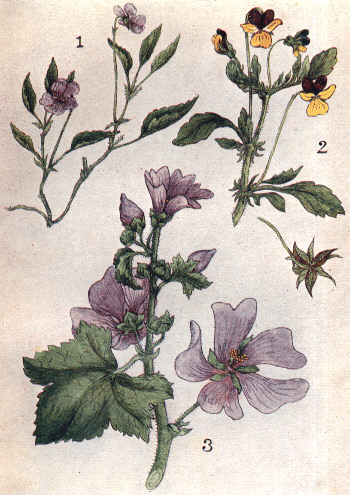 1. DOG VIOLET. 2. HEARTSEASE.
1. DOG VIOLET. 2. HEARTSEASE. The Dog Violet begins to flower early in summer. You find it growing on banks under the hedges, a tiny plant with flowers so small and stalks so short that the flowers are of no use after you pluck them.
Every child knows what a violet is like, but you should pick one of the flowers to pieces and see how curiously each petal is shaped. There are five petals, and these petals are pale purple at the broad part, but at the narrow end they are almost pure white, and this narrow end is hidden among the green sepals. Four of these petals are nearly the same size, and on two of them there are patches of hair near the foot.
The fifth petal is much larger, and the narrow end of this broad petal is shaped like a round tube. This tube, instead of being hidden among the sepals, stands out beyond them like a spur. Inside the tube are the stamens, and all the yellow heads of the stamens are joined edge to edge in a ring round the seed-vessel.
The Dog Violet has five green sepals with very sharp points, and the lower part of each sepal is slightly swollen. The leaves are heart-shaped, with toothed edges, and they grow very close to the ground and have scarcely any stalks. This Violet has no scent.
The Heartsease is not quite so common as the Dog Violet, though in some parts of Britain it grows abundantly. It is in flower all summer.
The flowers have five petals, but these are not all the same colour. There are two deep purple petals and three which are bright orange-yellow. In the Heartsease the broadest petal has a very small tube at the narrow end, the same as in the Dog Violet. There are five pointed green sepals, which do not fall off after the flower is withered. You will often see the seed-vessel sitting among these sepals, and when this seed-vessel is ripe it splits open into three small boat-shaped cases, each with a row of seeds inside.
The stem of the Heartsease is round, with distinct lines running up the sides.
The leaves are oval, on short stalks, and they have wavy edges. Where they and the flower-stalk join the main stem you find a fringe of other green leaves, quite differently shaped. These leaves have a long name which you will learn later, but meantime you should notice how they are cut up into little green straps which stand out all round the stem.
The Common Mallow is a handsome flower which grows by roadsides and in waste places. It is plentiful all summer and autumn. The five petals are a beautiful pale mauve streaked with purple. They are long and rather narrow, and each petal has a deep notch in the outer edge. These petals do not meet close together at the bottom; you can see part of the green calyx appearing between each petal.
In the middle of the flower stands a small purple pillar. In this pillar all the slender stems of the stamens are joined together, and their heads cluster near the top like tiny beads, with the wavy points of the seed-vessel rising among them.
This Mallow has two kinds of green sepals. Five of these are broad, with sharply-pointed tips and hairy edges. And besides these there are three long narrow sepals.
The green leaves of the Mallow are very pretty. They are shaped like a hand with five blunt points, and the edges all round are cut into delicate teeth.
Those leaves which grow close to the root have often a deep purple blotch near the centre.
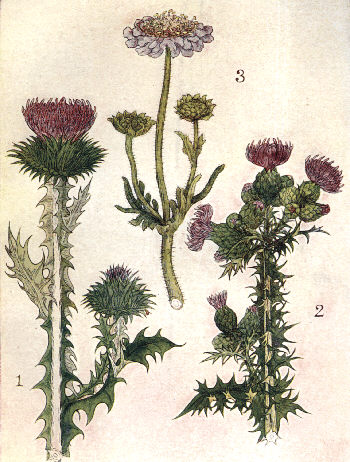 1. SCOTCH THISTLE 2. MARSH PLUME THISTLE
1. SCOTCH THISTLE 2. MARSH PLUME THISTLE This Thistle is very well known, particularly in Scotland, where it is the national flower. It blooms in late summer and autumn.
The stem of the Scotch Thistle is very stiff and straight, with 'wings' at each side. These wings are pale green flaps edged with very sharp points, and they run from top to bottom of the stem. The stem itself is white and woolly.
The Thistle flowers are a dull purple colour, and grow in a dense head, forty or fifty of them closely packed together. If you pick to pieces one of these heads, you will find that it is made up of many purple tubes which are edged with five purple teeth. The foot of each tube is enclosed in a covering of dingy yellow down.
When you have a great many of these flowers growing close together in a head, the under part looks like a bundle of woolly down.
Below this down bundle you find a prickly green covering, in which there are dozens of narrow green leaves. Each leaf ends in a sharp point, and it is this prickly green covering which makes the Thistle such a difficult flower to gather.
The leaves have very sharp points at the edges. They are dark green, and are thinly covered with beautiful grey down. The young leaves are entirely white and woolly until they open.
The Plume Thistle is very common all over Britain. It grows during summer in bogs and in wet places by the roadside.
This tall, thin plant is not nearly so attractive as the Scotch Thistle.
The flowers grow in heads which contain a great many dull purple flowers crowded together in one bundle. These heads do not grow singly as in the Scotch Thistle. You will find three or four close together at the end of the main stem, and there is usually one head of flowers much further out than the others.
The green covering which protects the lower part of the flowers and binds them together is not hard and prickly as in the Scotch Thistle. When you pick this covering to pieces you find that it is filled with woolly down.
The stem of the Marsh Plume Thistle is stiff and straight, and it has green wings with very sharp prickles up each side.
The leaves are long and narrow, and they are edged with sharp points. Each leaf is dark green above, but underneath it is covered with white down.
This pretty plant is common over most of Britain. You find it on dry banks and by the edge of fields, and it blooms all summer and autumn.
The flowers are very interesting. They grow in a bouquet which contains many flowers crowded together at the end of a stout stalk.
The centre flowers are a reddish pink colour, and have many tall yellow-headed stamens standing up beyond them. The petals of these flowers are joined together into a tube which is unevenly divided round the mouth. If you open the tube gently, you will find that the stamens are clinging to the inside.
Outside these pinky flowers there is a border of purply-blue tube-flowers, and these are much larger than the group in the centre. At the mouth of each tube there is a purple strap, and these straps stand out like a frill round the bouquet.
Behind these flowers there is a double row of small pointed green leaves.
The stem leaves are shaped like a feather, and they have long narrow fingers growing up each side of a centre stalk. There is always a solitary finger at the end of the stalk, and each finger is covered with soft hairs.
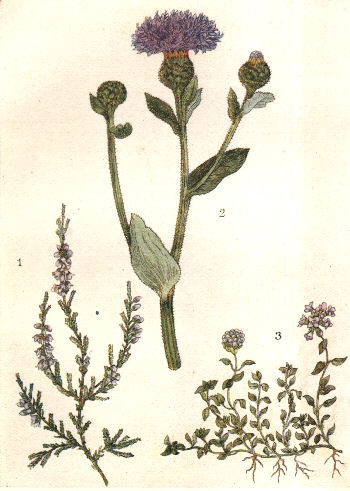
The Heather is so well known that it scarcely requires any description. It grows on moors and commons and mountain-sides in England, Scotland and Ireland, and in autumn you will find it covering the ground like a carpet, sometimes growing in bushes as high as your knee.
The flowers of the Heather are very tiny, and they vary in colour from a pale pink to a deep purple. These flowers grow in spikes near the end of thin woody stems, and each flower has a very short stalk which droops slightly. The small flowers are bell-shaped, with the mouth of the bell deeply divided into four parts. Outside this purple bell there is a calyx made up of four purple pink sepals. These sepals are much longer than the petals, and they are very crisp and dry, like tissue paper. There is a double row of tiny green pointed leaves, clasping the bottom of the purple flowers. At first you might mistake these for sepals, but they have a different name, which you will learn some day.
The Heather leaves are very tiny. They have no stalks, and they grow tightly pressed against the tough woody stems. When you look at them closely you see that the edges are rolled back so as almost to touch each other behind. When these leaves are withering they are often a beautiful brown-red colour.
This hard-headed plant is common everywhere, in pastures and fields and by the roadside, and it blooms in autumn.
The Black Knapweed is a stiff, soldierly plant, not unlike a small Thistle without prickles.
The flowers grow in thickly crowded heads each at the end of a stout stem. These heads are made up of dozens of tiny purple tubes with the mouth cut into five straps round the edge. You can see the forked end of the seed-vessel coming out of the centre of each tube. The stamens cling to the sides of the purple tubes, hidden from sight inside. This cluster of purple tubes grows on the top of a hard green ball which has a circle of light brown strap-shaped leaves round the top.
This hard ball is covered with row upon row of green leaves pressed tightly one above the other, like the scales of a fir cone.
When the flowers are in bud they are completely hidden inside this hard green ball, and after the flowers are withered you see these balls, which have become dark brown, still clinging to the ends of the stalks.
The Knapweed leaves vary much in shape. Some are narrow and long, with edges that are finely toothed. Some are deeply cut up at the sides. Those that grow clasping the stem are broad, and they are smooth all round the edge.
This sweet-scented little evergreen grows abundantly on all sandy and chalky pastures, and is specially common in mountainous districts. It flowers in summer and early autumn.
The Wild Thyme trails along the ground in a thick tangle of wiry stems and tiny glossy leaves. From this tangled mat some of the stems stand upright, and these bear masses of small purple flowers at the top. Other stems end in a tuft of tiny leaves.
The flowers of the Wild Thyme consist of a narrow purple tube which stands in a deep green funnel-shaped calyx. The mouth of the flower-tube is cut in two, and the upper half has a small notch in the centre. The lower half is divided into three blunt points.
Inside the tube, clinging to its sides, are four stamens. After the flowers are withered you can see the tip of the seed-vessel coming out of the mouth of the calyx.
The calyx is funnel-shaped and has many sharp teeth found its mouth, and there is a fringe of white hairs just inside.
The leaves of the Wild Thyme are very small. Sometimes the edges are rolled back till they almost meet behind. They are dark green and glossy, with smooth edges, on which you can see a line of fine hairs.
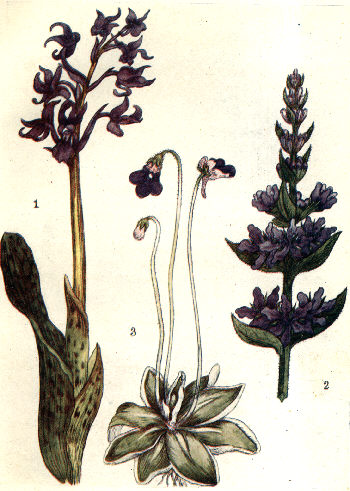
At the same time of year, and in the same places as you find the Blue Hyacinth, you will discover the Early Purple Orchis.
It is a curious plant, and belongs to a family whose flowers are always strangely shaped.
The flowers grow in a cone-shaped head at the upper end of a stout, juicy stalk. Each flower consists of three purple petals and three purple sepals, and you will not be able to distinguish which are which. These petals or sepals are very irregular in shape. One is broad, and hangs open like a lip. This one has a long purple spur behind. Two smaller petals rise straight up above this lip and form a hood. And the others are shaped in varying ways.
Inside the broad lip with its hood you see a slender column, in which the one stamen as well as the point of the seed-vessel are combined.
The flower is placed at the end of what looks like a twisted purple stalk. This is really the seed-vessel, and where it joins the flower-stem there is always a narrow strip of purple leaf.
The leaves have no stalks. They are broadly strap-shaped with blunt ends, and they have long narrow lines running from base to tip. Each leaf is stained all over with purple spots.
The root of the Early Purple Orchis consists of two egg-shaped knobs, and above these knobs grow many white, worm-like rootlets.
The Purple Loose-strife is common in all parts of England, but you do not find it so abundantly in Scotland. It is a tall, spiky plant, which likes to grow in wet places, and it blooms in late summer and autumn.
The flowers are a rich purple colour which is sometimes almost pink. They grow in circles close round the main stem, and there is always a pair of broad pointed green leaves separating each circle from the one above.
The flowers have six separate petals, which are long and narrow and rather crumpled looking. These petals are placed at the mouth of a green calyx, which is shaped like a thick tube. This tube is ribbed all over, and has six large green teeth and six smaller green teeth round its mouth. If you gently split open this green tube you find two rows of stamens clinging to its sides. These stamens have purply-pink heads, and there are six long ones which stand up in the centre of the flowers, and six which are shorter and hidden out of sight.
The leaves of the Purple Loose-strife are dark green. Usually they are covered with fine hairs, but sometimes you find leaves which are quite smooth. It is easy to recognise this plant by the rings of flowers growing close round the main stem.
It is always a delight to find the dainty Butterwort. It grows in heaths and bogs and marshes almost everywhere, but is most abundant in the North. The delicate flowers bloom in summer.
You will easily recognise this beautiful highland plant by the leaves. They are thick and juicy, and grow close to the ground in a pale green star-pointed rosette. Each leaf is stalkless and as smooth as satin. On the upper side these leaves are pale yellow-green, but sometimes the edges curl upwards, and then you see that the leaf underneath is so pale that it is almost white.
From the centre of the rosette rise tall, slender stalks with drooping flower-heads. These flowers are dark bluey-purple, and their petals are joined into a short tube which stands in a shallow, toothed calyx-cup.
The mouth of the tube folds back in two parts. The upper half is short, with a deep notch in the middle. The lower half is much longer, and is divided into three deep scollops.
You will find a pink horn-like spur standing up near the base of the short tube, and you can see that the back of the flower is a delicate rose pink colour. Inside the blue tube there are two stamens and a curiously shaped seed-vessel hidden from sight.
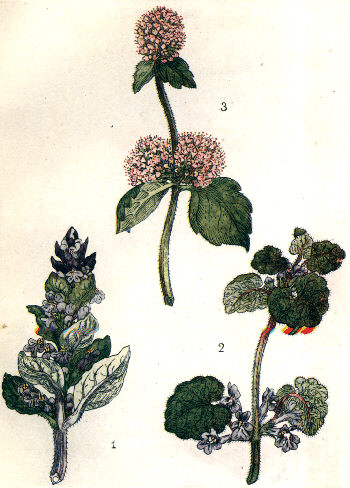 1. COMMON BUGLE. 2. GROUND IVY.
1. COMMON BUGLE. 2. GROUND IVY. The Common Bugle is a low-growing plant, very frequently found in open woods, banks, and pastures. It blooms in spring and early summer.
You will not think this a very attractive plant. The leaves and flowers are crowded together from top to bottom of the main stem. The stem is pale purple, and has four sides. It is hollow in the centre, and breaks off easily because it is soft and juicy.
The flowers grow without stalks in circles close to the stem wherever the leaves join it, and each circle is close to the one above it.
In every flower there is a slender tube, and one half of this tube folds over at the mouth into three lips, the centre lip having a notch in the middle. The other half of the tube stands erect.
These flowers are usually deep blue, but you may find them purple, or rose colour, or even white. They are never yellow.
Four golden-headed stamens stand up a good way beyond the mouth of the flower; two of these are short and two are much longer. The forked tip of the seed-vessel can be seen among these stamens.
The end of each tube stands in a small green calyx-cup edged with pointed teeth.
The leaves of the Common Bugle are dark green, and each pair clasps the stem closely at the bottom.
The Ground Ivy bears little resemblance to the ivy we all know so well. It is common everywhere, and blooms in spring and early summer.
The flowers grow without stalks in whorls or circles close to the stem where the leaves spring from it. These flowers are dark purply-blue tubes, prettily divided at the mouth into rounded lips. The lower lips are marked with white and dark purple blotches. Inside the tubes are four small stamens with yellow heads; you can just see them at its mouth, with the forked tip of the seed-vessel among them.
There are usually six or more flowers in a whorl, and each flower has a green calyx-cup which is very hairy and is edged with five long sharp teeth.
From each side of the stem, close among the flowers, grow two leaves on pink stalks. These leaves are round and are beautifully scolloped at the edge. Each leaf is covered with a network of veins and is hairy all over, both above and below, as well as round the scollops.
These circles of leaves and flowers grow at intervals all the way up the stem, with a good distance between each circle, and the flowers in the lowest circles always come out first.
The stem of the Ground Ivy is four-sided. It is tinged with pink and is very hairy.
This strong-smelling plant is common everywhere. It likes to grow in wet places, and it is in flower towards the end of summer and in autumn.
The Water Mint is not an attractive plant. It has four-sided juicy green stems stained with purple. These stems do not grow straight.
The flowers grow in pink clover-shaped heads, either at the end of the main stem or sometimes on very short stalks which spring from between the stem and the leaf.
Each pink head is made up of many tiny tubes. These tubes are prettily cut round the mouth, and you can see four stamens, with deep crimson heads, coming out of the mouth of each tube. The forked tip of the seed-vessel is so tiny you scarcely notice it.
Below the flower there is a deep funnel-shaped calyx in which each pink tube stands, and both it and the flowers are covered with fine soft hairs. There is often a pair of small oval green leaves just beneath the head of flowers.
The leaves of the Hairy Water Mint are broadly oval with widely separated teeth round the edge. They grow in pairs on short stalks on each side of the main stem, and they are hairy all over.
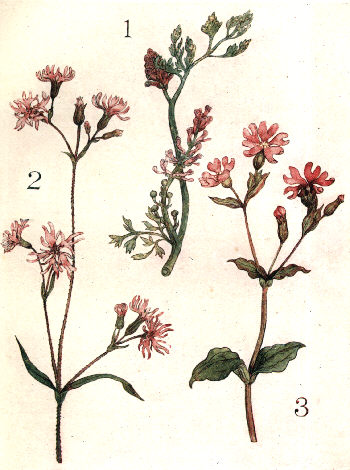 1. COMMON FUMITORY 2. RAGGED ROBIN
1. COMMON FUMITORY 2. RAGGED ROBIN The Common Fumitory is abundant in all parts of Britain, and it blooms in summer. The flowers grow in loose clusters. Those that are lowest down the stem come out first, and the buds are always at the top of the stem.
The flowers are a pretty rose pink colour, but the tips are often purple, especially before the flower is fully out. The petals are curiously shaped. They are joined together into a tube which is curved at the end, and inside this tube the stamens and the seed-vessel are hidden. You will notice that there is a tiny piece of one petal which is not joined to the others. It stands out by itself and looks like a small pink tongue, which broadens at the end. You can always recognise the Fumitory by this pink tongue.
There are two tiny green sepals with edges cut like the teeth of a saw, and the pink tube lies in between these sepals. After the pink tube falls off, the seed-vessel, which is inside, grows into a little green knot. You can see many of these little green knots on the lower part of the stem where there have once been flowers.
The green leaves of the Fumitory are very delicate and pretty. They are finely cut up into many little divisions, and each division is a beautiful shade of grey-green.
This untidy plant likes to grow in damp places; it is very common in meadows and in marshes, and it blooms all summer.
The flowers grow in twos and threes, on short stalks which branch opposite each other near the end of a long slender stem.
The petals are a delicate pale pink, and they are very much cut up into narrow ragged pieces. You will easily know the Ragged Robin by these pink petals.
The sepals are joined together into a cup which is cut into teeth all round the mouth. They are dark green tinged with red, and have many purple veins running from top to bottom.
The leaves of the Ragged Robin are shaped like a lance. They are long and narrow with smooth edges, and they grow opposite each other in pairs, closely clasping the stem. Those leaves that grow close to the ground have sometimes short stalks.
The upper part of the sticky stem is dark red in colour, and it is usually rough.
This pretty summer plant is fond of damp places like its cousin the Ragged Robin.
It has pink flowers, which usually grow in pairs at the end of slender stalks branching from the main stem. Sometimes you may find a single flower growing on a small stalk in between two pairs on much larger stalks.
There are five petals, each with a deep nick in the centre, as if a three-cornered piece had been cut out. These petals lie flat open round the rim of the reddish-green cup formed by the sepals; and if you pull the sepals apart, you find that the petals have long strap-shaped ends which go right down into the cup.
There is a curious thing about this plant. You find one pink flower with a bunch of stamens inside the cup. You can see their tips peeping out where the pink petals all meet together. There is no seed-vessel in the middle. And in another plant, that looks just the same till you examine it, you find no stamens, but instead there is a green seed-vessel in the centre of the cup, with fine, wavy green threads at the top which stand out where the petals join.
The stem of the Red Campion is red and sticky, and the leaves grow opposite each other in pairs which clasp the stem.
If you crush the leaves and stalks they give out a strong scent which is not pleasant.
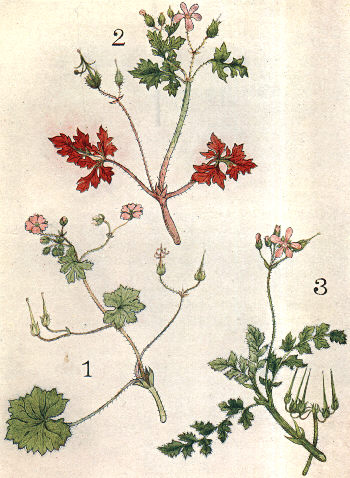 1. DOVE'S-FOOT CRANE'S-BILL 2. HERB-ROBERT
1. DOVE'S-FOOT CRANE'S-BILL 2. HERB-ROBERT The Dove's-foot Crane's-bill is known to us all. You will find it flowering by the roadside from May to September.
The flowers are small and pink, sometimes almost purple. They have five petals, each with a notch in the broad end and with many fine hairs near the narrow end.
The flowers open flat, like a wheel, and you can see the green tips of the sepals appearing between each of the pink petals, as you look down into the flower.
After all the pink petals have fallen off, a thin green spike shoots up in the middle of the sepals. These sepals no longer lie flat open, but half closed, they form a green cup. The spike holds the seeds, and when it is time for them to be scattered over the ground, five green threads loosen themselves from the bottom of the spike and curl up nearly to the top. At the end of each of these green threads there is a seed, and very soon the green threads crack and the seeds fall to the ground.
The leaves of the Dove's-foot Crane's-bill are very soft and downy. They are round in shape and are covered with fine hairs. Each leaf is divided into seven parts, which are toothed round the edges.
This plant has a weak stem, which lies near the ground. It is tinged with pink, and is very hairy.
The Herb-Robert is common everywhere in early summer. It is a cousin of the Dove's-foot Crane's-bill, but differs from it in some points which you must notice. The stems are much stronger and can stand upright.
The flowers are longer than those of the Dove's-foot Crane's-bill, and the five petals have no notch in the broad end, and no hairs at the narrow end. These petals are pale pink, streaked with white or purple, and they grow in pairs at the end of short stalks which branch near each other from the main stem.
The sepals are of two kinds. You have three outer sepals which are green and hairy, and inside these there are two others which are very thin and almost colourless.
The seeds of the Herb-Robert are scattered in the same way as those of the Dove's-foot Crane's-bill.
You will always know this plant by its beautiful red leaves. They are shaped like a hand, and are cut up into many tiny fingers. At first they are green, but very soon they become a beautiful red colour. So do the stalks.
The whole plant has a strong and rather unpleasant odour.
The Stork's Bill is very well known. In summer it grows plentifully on dry ground, especially near the sea coast.
The flowers grow on short stalks. You will find a bunch of five flower-stalks rising together at the end of the main stem. Each flower has five pretty pink petals with smooth edges. These pink petals soon fall off, and you then notice a long green spike coming out of the green cup formed by the sepals. Each green spike is supposed to resemble a stork's bill, and from this resemblance the flower gets its name.
When the plant is ready to scatter its seeds, many fine green threads loosen themselves from the spike, and curl round and round like a corkscrew. At the end of each green thread there is a seed. When the seed is ripe, both the seed and the corkscrew-thread separate from the spike and fall to the ground.
The green leaves of the Stork's Bill are cut up into leaflets which are arranged on each side of a centre stalk, but not always exactly opposite each other. There is always a single leaflet at the end of this centre stalk.
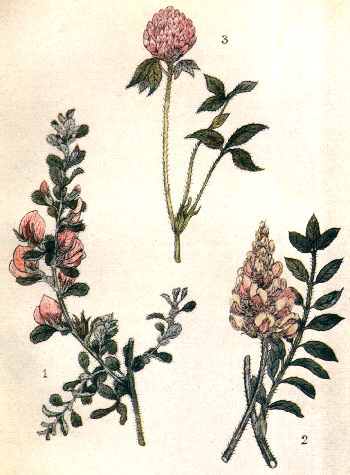 1. REST HARROW. 2. SAINTFOIN.
1. REST HARROW. 2. SAINTFOIN. The Rest Harrow is to be found in sandy places near the sea, and blooms all summer.
It belongs to the Pea family, along with the Broom and the Whin. But in this plant the flower-petals are a beautiful rose-pink colour.
The largest petal, which is called the standard, is streaked with veins of deep red. The two side petals, or 'wings,' are pale pink, and the tip of the two 'keel' petals, which are joined together into a little boat and hide the stamens, is also a deep rose-red.
The flowers have scarcely any stalks. They grow close to the main stem, in a green calyx-cup edged with five sharp teeth, and there are small green leaves beside each flower.
These leaves are dark green in front but are much paler behind, and they have tiny teeth all round the edges.
Sometimes, close to the root, you find leaves which grow in threes, but oftenest the plant has single oval leaves, and these are always covered with fine hairs.
The Rest Harrow usually lies close to the ground, but you may find it growing upright like a small bush.
It has long, tough roots, which creep through the soil, and these are said to be so strong they will turn aside the harrow when it is drawn over the field.
Some people tell us that this is not a British wildflower, but one which was brought from some other country to grow in our gardens. They say that the wind and the birds carried away the seeds, and the plant learned to grow among our other wildflowers. In any case, you find its handsome flowers adorning chalky banks and cliffs all summer and autumn.
Like the Rest Harrow it is a relation of the Pea family, but its flowers grow quite differently.
In colour they are not such a clear pink. The two petals which hide the stamens are almost purple, and the side wings are so tiny, at first you scarcely notice them.
The flowers grow close together in the shape of a cone; you find twelve or more open flowers with no leaves among them, crowded together near the upper end of a long flower-stalk, and at the top of this flower-stalk there is always a bunch of buds.
The calyx is a green cup with five sharp teeth round the mouth, and it is covered with woolly hairs.
The leaves of the Saintfoin are long and narrow, and the edges are quite smooth. Each leaf is made up of from eight to twelve pairs of leaflets growing opposite each other on a leaf-stalk, and there is always a solitary leaflet growing at the end of the stalk.
The Red Clover is as well known as the Buttercup. It grows all summer in every hayfield. Sometimes the flowers are large and showy, and sometimes they are quite small.
The Red Clover is a member of the Pea family, though at first you may not think that the flowers are at all like those of the Broom or the Rest Harrow. These flowers grow in a round head, thirty or forty of them close together at the end of the flower-stalk.
If you pull a single flower apart from the others and separate the petals, you will see that they are shaped in the same way as those of the other Pea plants.
You find one large standard petal which stands erect, rather a long, narrow petal in this plant. Then there are two side petals for the 'wings,' and two front petals joined together so as to form a tiny boat, and in this boat the stamens and seed-vessel are hidden.
These petals are a pale pinky-red, and each flower is set in a green calyx-cup edged with five long teeth.
The leaves of the Red Clover are 'Trefoils'; that means that they grow in groups of three. Each group has a short stalk, and there are curious yellow markings in the centre of each oval leaf. The edges are smooth, and the leaves are covered with fine downy hairs.
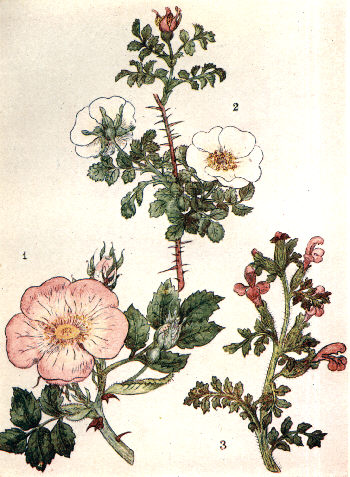 1. DOG ROSE 2. BURNET ROSE
1. DOG ROSE 2. BURNET ROSE There are a great many wild roses, pink, white, and crimson, but the pink Dog Rose is the commonest. Every one has gathered it in the sunny June days.
You must notice a curious thing about the seed-vessel of this plant. Only the top of it rises in the middle of the stamens. But if you look at the back of the flower, you see a small green swelling at the end of the stalk, and the sepals and petals and the stamens stand in a ring round the top of this swelling. This is the seed-vessel, and in autumn, after the flower is withered, it will grow into a round red berry, which is called a hip.
The sepals of the rose are very pretty. They are cut up into many points like small leaves, and after the flower is withered these points fold right back and cover the green berry. Later on they dry up and fall off, leaving the berry bare.
The rose leaves are too well known to need any description. Notice the two narrow green leaves, like wings, which grow at the foot of the leaf-stalk, clasping the main stem.
The Dog Rose is very thorny. There are large hooks all over the main stem, as well as close to the flower, and these hooks are often coloured a bright crimson.
The Burnet Rose is different in several ways from the Dog Rose. It grows in early summer on sandy sea shores and on heaths, but not in the hedges, and the flowers are usually white.
It is a much smaller plant than the Dog Rose. Its leaves grow closely crowded together in a small, low bush, and there are no long shoots running out from the plant.
The main stem of the Burnet Rose is a bright pink colour, and instead of having big hooks here and there it is covered from top to bottom with fine sharp prickles of all sizes.
The green sepals are pointed, but they are not cut up into leafy tips as in the Dog Rose. Neither do they fold back over the seed-vessel after the flower is withered, but remain standing straight up at the top of the berry.
The seed-vessel of this rose is rounder than the hip of the Dog Rose. When ripe it is a dark purple colour which is almost black.
The leaves are made up of leaflets which grow in pairs opposite each other on a leaf stalk, and there is always an odd leaflet at the end of the stalk. They are small, nearly oval, and the edges are cut all round into fine teeth.
This bright plant is common all over the country. It grows in wet places, such as bogs and damp fields, and it is in flower from spring to autumn.
The Lousewort is a small plant and does not rise very far above the ground. The flowers are bright pink, and they grow singly at intervals up the main stem. The flowers are curiously shaped. The lower part is round, like a narrow pink tube, but at the mouth this pink tube becomes much wider and is divided in two. One half rises straight up and then bends over at the top like a hood.
Inside the pink hood are hidden the yellow heads of the stamens. The other half of the flower is divided at the edge into three pink scollops, which fold back so that you can look inside the tube of the flower. After the pink flowers are withered the calyx-cup swells into a small bladder, and on windy days you can hear the seeds rattling inside this bladder.
The stem of the Lousewort is hairy, and the leaves grow very close to it. These leaves are made up of small fingers with deeply toothed edges, which grow in pairs on each side of the centre leaf-stalk. There are frequently six pairs of these fingers on one stalk, and there is always a single finger at the end of the stalk.
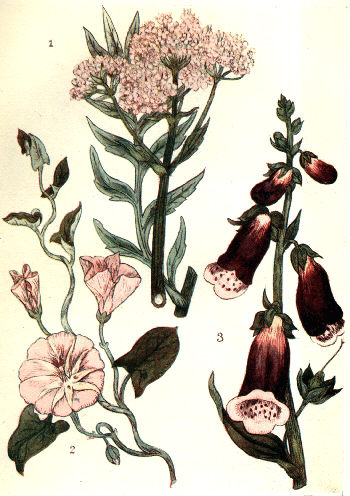 1. GREAT WILD VALERIAN 2. SMALL BINDWEED
1. GREAT WILD VALERIAN 2. SMALL BINDWEED You find the Great Wild Valerian in most parts of Britain. It grows in marshy meadows and in damp woods, and is in flower all summer.
The Wild Valerian is a tall, handsome plant. It has small pale pink flowers, which grow in thick clusters on long, stiff green stalks rising from the main stem.
If you pull off a single flower you find that its five pink petals are joined together at the bottom into a tube. This tube folds back at its mouth into five pink scallops, and you can see three yellow-headed stamens coming out of the mouth of the pink tube. If you gently split the tube open you will discover that these stamens are clinging to its sides.
The green sepals of the Wild Valerian are also joined into a tube which has five teeth at the top, and after the pink petals are withered, this green tube sends up a tuft of beautiful feathery down.
The stem is dark and glossy. It is ribbed all over and is hollow inside.
In the Wild Valerian each leaf is divided into fingers, which grow in pairs on each side of a slender stalk. Sometimes there will be ten pairs of these little fingers, and you will notice that each finger is not placed exactly opposite its neighbour, but that they grow alternately.
The Small Bindweed or Convolvulus is common everywhere. You find it in the hedge-banks, on waste places and in fields, and it blooms all summer.
This pretty plant is very well known by its pale pink or pure white flowers. These flowers have a narrow tube which fits into the small green sepal-cup. But round the mouth this tube widens out into a beautiful bell, and the edges of the bell are gracefully waved all round. Inside the flower there are curious markings like large cream-coloured rays, and you must notice how wonderfully the flower of the Bindweed is folded when it is in bud.
The stem of the Bindweed is very curious. It is twisted like a piece of rope. This stem clings to any stronger plant within reach, and it will twist itself round and round that plant till it nearly chokes it.
The leaves are dark and shiny with smooth edges, and they are shaped like the head of an arrow. Each leaf has a short stalk of its own.
This is one of the handsomest of our wildflowers. It grows abundantly in woods, on banks and in fields, and it flowers all summer and autumn.
The Foxglove is a tall plant with a very stiff stem, from one side of which hang beautiful rose-pink and purple bells.
These fairy bells are daintily scolloped round the mouth, and the pale pink lining inside is dotted all over with purple spots. When you look down the mouth of a Foxglove bell you see that two long and two short stamens with large yellow-heads are clinging to its side, and rising from the centre of the bell there is a fat green seed-vessel which sends up a slender yellow thread.
Those bells which are nearest the bottom of the stem come out first, and the buds are always found at the top. Behind each bell there are five green sepals with sharp points, and wherever the flower-stalk joins the main stem there is always a small green leaf.
The Foxglove leaves are broad and long, and they are pointed at the end. Each leaf is covered with a network of fine veins. These leaves are grey-green in colour, and the underside is hoary with soft, white woolly down.
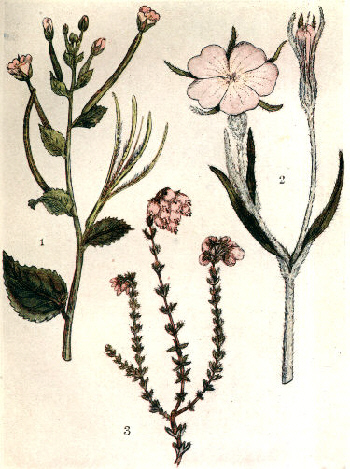 1. BROAD-LEAVED WILLOW HERB 2. CORN COCKLE
1. BROAD-LEAVED WILLOW HERB 2. CORN COCKLE The Broad-leaved Willow Herb is common in most parts of Britain. You find it growing on old walls, in woods and under hedges, and it blooms all summer and autumn.
It is a tall, thin plant, and has small pink flowers with four petals, each of which has a V-shaped notch cut in the outer edge. Behind these pink petals there are four narrow pointed green sepals, and within the flower grow eight stamens with tiny yellow heads. Amongst these stamens you can see the slender pillar which rises from the seed-vessel; it is divided at the top into four yellow rays.
The flowers grow singly, each at the end of a long thin pod which is slightly red in colour. When the petals and the green calyx fall off, this pod grows larger, and as soon as the seeds inside are ripe, it splits open into four strips, and each strip is lined with a row of small brown hairy seeds.
The leaves of this Willow Herb are oval, with pointed tips, and they are cut into sharp teeth all round the edge. These leaves are dark green, and usually they are smooth all over, but you sometimes find leaves which have hairs along the veins.
The stem is quite smooth, and it is red on the side which gets most sunshine.
The Corn Cockle is common everywhere. It grows in the cornfields, and you find its pink flowers all summer.
The flowers are large and handsome. In shape they are like a Primrose, but the petals are pale pink and each has a tiny notch in the outer edge. On these petals there are tiny lines of dark purple dots, like rays, which run from the centre of the flower almost to the edge of the petal. The heads of the stamens can only just be seen in the centre of the flower where the five petals meet.
Behind the pink flower there is a green calyx-cup marked with ten ridges, and at the mouth of this cup there are five narrow green teeth, which are so long they look like pointed leaves. These sepals are dark green inside, but the outside is pale green and woolly. You can see their sharp points standing out beyond each of the petals of the flower.
The stem of the Corn Cockle is stiff, and it grows very straight. Like the calyx-cup, it is covered with soft white wool.
The leaves grow in pairs on each side of the stem. These leaves are long and narrow, with pointed ends. Each leaf is dark green above, but the back is always pale grey-green and woolly.
This waxen Pink Heath is to be found all over the country. It grows best in damp places, and is in flower in late summer and autumn before the purple heather is fully out.
The flowers grow in clusters of from five to twelve at the top of the woody stem. Each cluster is made up of pale pink waxy bells, and the mouth of each small bell is edged with four pointed teeth. If you split open one of these pink bells, you will find inside a round green seed-vessel like a tiny pea.
There is a long green spike growing from the top of this seed-vessel, and you can see its point coming out of the mouth of the pink bell. There is also a ring of yellow stamens hidden inside the bell, and these grow close round the green seed-vessel.
The leaves of this Pink Heath are very small and pointed, and they have hairs along the edge. They grow in fours, and are placed crossways at short distances up the main stem. The edges are usually rolled back on to the woolly underside of the leaf.
The stem of the Cross-leaved Pink Heath is slender and wiry, and this pretty plant is never found growing in large bushes like the common heather. Sometimes the flowers are pure white.
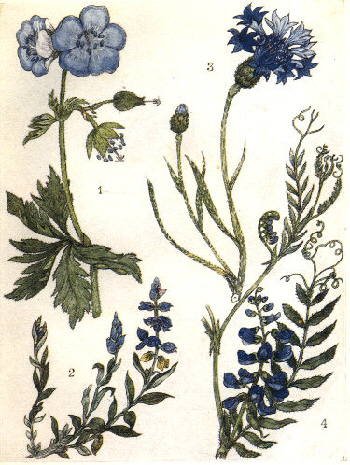
The Blue Meadow Crane's-bill is one of our handsomest wildflowers. It is to be found by the edge of the fields and in the meadows all over Britain in summer and autumn.
This plant is related to the beautiful geranium which grows in our gardens. The flowers have five large petals. In front these petals are bright blue and are painted with tiny pink streaks. Behind, they are a delicate pale pink.
In the centre of the flower there is a ring of stamens, and within this ring is the seed-vessel.
There is a circle of green sepals behind the pinky-blue petals.
After the blue petals are withered you can see a long spike with a small star at the end coming out from among the sepals.
This spike has five seeds clustered round the bottom, and whenever these seeds are ripe, the spike splits into five fine hairs. Each of these hairs curls up to the top, carrying a seed with it. Then the five seeds are blown by the wind away from the slender hairs.
The leaves of the Blue Meadow Crane's-bill are beautifully shaped. They are like a hand with five thin fingers, and each of these fingers is deeply cut up all round the edges.
The stem of the plant is covered with rough, hairy bristles.
The Milkwort has flowers which are not always the same colour. You may find them either pink, or blue, or white, but I think the blue Milkwort is the commonest. It blooms all summer.
The flowers grow on spikes in which the buds are always at the top, and further down the same spike there are leaves. Each flower has five sepals. Three are only small green strips, but inside these three there are two which are large and broad, and beautifully coloured. These look like petals.
When the flower is withered these two sepals change colour and become green.
The real petals are paler in colour than the sepals. The lowest one is cut up at the end into little strips like a blue fringe, and there are two small side petals as well as two upper ones, which are so tiny that they are merely scales.
The leaves resemble narrow straps. They grow alternately on the stem, and they are dark green above and pale green below.
The Milkwort lies close to the ground among the grass. You would never notice it, were it not for its beautiful spikes of blue, pink-white flowers.
The Corn Flower or Blue Bottle is common all over Britain; you find it in the cornfields and by the roadside, and it flowers all summer and autumn.
This pretty plant belongs to the same family as the Thistles. The flower-heads are made up of a great many flowers grouped together. In the outer row you find a circle of beautiful bright blue flowers, each of which consists of a blue tube which widens out at the mouth like a trumpet, and is edged with seven sharp points.
Inside this outer circle there is a mass of darker blue flowers, slightly tinged with rose-colour. These flowers are very much smaller, and their pinky tubes are very tiny. So are the strap-shaped teeth at the mouth of the tube. Coming out of the mouth of each tube is the dark purple tip of the seed-vessel.
Underneath this bunch of flowers there is a double ring of green scales with fringed edges. These scales are tightly pressed together in the shape of a cup, but they are not prickly as in some of the Thistles.
The stems of the Corn Flower are very tough. The plant is tall and straggling, and it has narrow strap-shaped leaves with smooth edges. These leaves, as well as the stems, are often covered with white woolly down.
The Tufted Vetch is a very common plant, and all summer-time you find its masses of bright blue or purple flowers growing up the hedges. It belongs to the large family of Pea-plants, along with the Broom and the Trefoils, and you will find that its bright bluish-purple petals are shaped as curiously as those of the other Pea-plants.
Do not forget to look at the stamens. You will see that there is one stamen whose slender stem is not joined with the others, but has a separate stalk of its own.
The flowers grow in clusters on a stiff stalk; the buds are at the end of the stalk, and the flowers that grow lowest on the stalk always open first. When the flower is withered, the seed-vessel grows into a small green pea-pod which has a curly tail at the end, and when the seeds are ripe, this pod turns brown.
The leaves are made up of short pointed straps, set opposite each other in pairs on each side of a thin stalk. You will often find ten pairs of little straps, and at the end of the stalk there grow curly green threads called tendrils. This Tufted Vetch is one of these climbing plants which are not strong enough to stand alone; so these tendrils curl themselves round the twigs of the hedges, and this helps the plant to rise high above the ground.
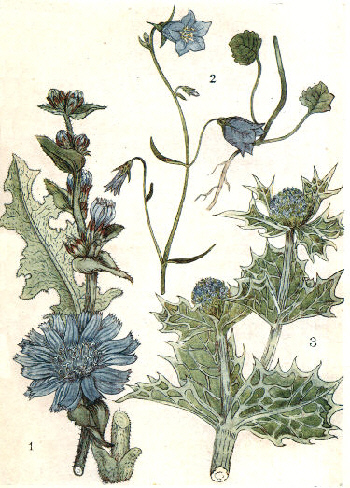 1. WILD SUCCORY. 2. BLUEBELL OR HAREBELL.
1. WILD SUCCORY. 2. BLUEBELL OR HAREBELL. The Wild Succory is abundant all over England, but is not so plentiful in Scotland. It grows by the borders of fields, in waste places or by the roadside, and it blooms in late summer and autumn.
The flowers are like large blue dandelions. They have no stalks, but grow from top to bottom of the main stem.
The flowers at the bottom of the stem come out first and the buds are always at the top. Each of these large blue dandelions is made up of a great many tiny tubes grouped together.
In the inner circle there are a great many blue tubes which have no strap, but in the outer circle the flowers have a broad blue strap at one side, and the end of this strap is cut into fine teeth. In the centre of each tube you see the tip of the seed-vessel standing up. It looks like a white thread with two curly points at the end.
The heads of the stamens are placed edge to edge and form a collar close round this white thread.
Behind the blue flowers there is a green calyx-cup of narrow strap-shaped leaves, with reddish-brown tips. There is always a large pointed green leaf where the flower-bud joins the main stem.
The leaves of the Wild Succory are rough and hairy all over, and are a grey-green colour.
The Bluebell or Harebell is one of our prettiest wildflowers. It is common all over the country on heaths and on pastures, and it blooms in late summer and autumn.
The five petals of the flower are joined together into a beautiful bell. This bell is divided round the mouth into five pointed scollops, and when you look into the mouth of the bell you can see the yellow heads of the five stamens and the three-cornered top of the seed-vessel.
The flowers grow singly, on many very slender stalks which branch from the main stem.
The green calyx-cup behind the Bluebell is curiously marked with raised lines. It is deeply divided into five sharp green points, which stand out like the rays of a star at the back of the Bluebell.
The leaves of the Harebell are of two kinds. Those that grow on the main stem, where the flower-stalks branch from it, are narrow and pointed. But the leaves that spring from the root are quite different.
They are nearly round, with edges which are cut into large teeth, and each leaf has a stalk.
This curious plant grows on sandy seashores in England, but it is not common in Scotland, and it will not grow far North.
The flowers grow in clover-shaped heads at the ends of very stiff stems. These flowers are very small, of a whitish-blue colour, and they are not at all attractive. If you examine one closely you find that the petals stand straight up, and each petal has a pointed beak which bends forward towards the centre of the flower. The stamens also curve inwards.
Outside this cluster of flowers there is a crowded mass of small green leaves, and each leaf ends in three short points. These leaves are a yellow-green colour, but all the rest of the flower is a beautiful grey-blue.
The stems of the Sea Holly are stiff, with ridges running up them, and the leaves have no stalks of their own, but grow in a circle of three or five, tightly clasping the main stem. These leaves are very smooth and thick. They are grey-blue in colour, with yellow-green patches between the veins, and they have very hard edges which are waved all round. Each of these waves ends in a sharp point.
The Sea Holly is quite as prickly as the Christmas Holly, and as it grows low down among the sands, bare-footed children must be careful not to stand on it.
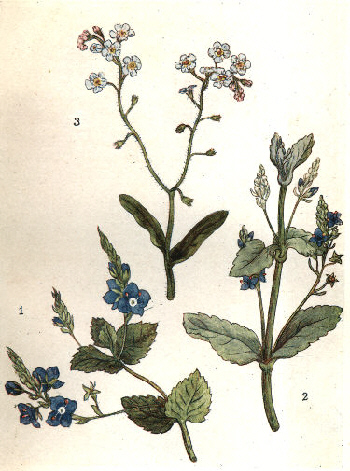
This bright blue flower is to be found on banks, and in woods and pastures all over the country. It blooms in spring and early summer. Many people call this the Forget-me-not, but that is not correct, and you should notice carefully the difference between the two plants. They are not really alike.
The Germander Speedwell is a slender, wiry plant, whose stem sometimes creeps along the surface of the ground before it grows upward.
The flowers have four small petals of the brightest blue, and within the flower at the foot of the petals is a small white circle, like a little white eye looking up.
Two stamens with crimson heads rise from this white circle, and in the very centre of the flower there is a tiny green seed-vessel, with a spike coming out of the top.
The four sepals are very narrow green straps with sharp points.
The dark green hairy leaves are oval, with the edges cut all round like the teeth of a saw. They have no stalks, and they grow in pairs opposite each other. The slender stems, which bear the flowers in loose heads near the top, spring from between the leaf and the main stem.
The Brooklime Speedwell is quite as common as its cousin the blue Germander Speedwell, but it grows in damp places. You find it in ditches and beside slow-running streams, and the flowers are in bloom from spring to autumn.
The plant has a round juicy stem, which is hollow in the middle. It rises straight up from its muddy bed.
The flowers have four small petals which are a dull blue in colour, and are not very attractive.
In the centre of the flower there is a tiny blue ring, and to this ring are fastened the two red-headed stamens.
The seed-vessel is a small green dot with a spike at the top. It is so tiny that you can scarcely see it until the blue petals have fallen off.
Behind the flower there are four small green sepals.
The leaves of the Brooklime Speedwell are smooth and glossy. They are oval with blunt points, and the edges are waved. These leaves grow in pairs opposite each other, and have very short stalks which widen out at the foot so as to clasp the stem.
The flowers grow in loose heads on a long thin stalk, which springs from between the leaf and the stem.
Every child knows the pale blue Forget-me-not with its dainty flowers. It has many varieties which are found all over the country, but the Water Forget-me-not is one of the loveliest, and grows abundantly in ditches and marshes from spring to autumn.
It is a tall straggling plant, with long flower-stalks which grow singly on alternate sides of the stem. Those flowers nearest the bottom of the stalk come out first, and they soon fall off. The pink buds are always at the very top of the stem, and the full-open flowers are close below them.
Each flower has five small round blue petals which lie open like a wheel, and in the centre of the flower there is a bright yellow eye.
The stamens are hidden from sight in the small blue tube below the petals. So is the seed-vessel. There is a green calyx-cup which is hairy all over, and round the mouth it is edged with sharply pointed teeth.
The leaves of the Forget-me-not are long and narrow, with blunt points and smooth edges. They are as glossy as if they were wet, and they clasp the stem.
The lowest part of the stem is four-sided and hairy, and it creeps along the mud before it rises up to bear the leaves and flowers.
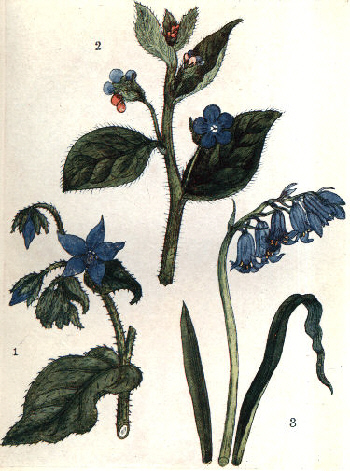 1. COMMON BORAGE. 2. EVERGREEN ALKANET.
1. COMMON BORAGE. 2. EVERGREEN ALKANET. The Borage is not a very common plant, though it is widely distributed throughout the country. You find it on hedge-banks and in waste places, and it blooms in summer and autumn.
It has beautiful bright blue flowers, with five petals which are gracefully pointed at the tips. These flowers droop either singly or in clusters at the end of stout, hairy stalks.
The stamens of the Common Borage have no thread-like stalks; their purple heads are placed close together in a circle round the slender white pillar of the seed-vessel. Notice the curious purple horns that rise from the back of each stamen. There is a ring of dark purple scales with white blotches on them at the base of the petals. The calyx has five long narrow pointed sepals. These are covered with bristly hairs, and so are the leaves, stalks, and stem.
The leaves of the Borage are a dusty grey-green colour. Wherever the stem forks, you find a large stalkless leaf clasping it. These leaves are usually oval, but they are very varied in shape, and those leaves that rise from the root are frequently quite different.
The stem is light green and is round, with a hollow in the centre.
Some people do not consider this one of our native plants, but it is widely distributed over the country. You find it in hedge-banks and by the roadside in spring and autumn.
The Alkanet is an erect, hairy plant, which is not quite so bristly as its cousin, the Common Borage.
The flowers have small blue tubes, lined inside with white, and there is a deeply waved sky-blue wheel round the mouth. When in bud the flowers are deep pink. These flowers grow either singly or two or three together, at the end of straight stalks which rise from between the leaf and the stem.
There are five purple-headed stamens clinging to the white lining of the tube, and there is also a tiny seed-vessel. These you cannot see until you pick the flower to pieces.
The mouth of the calyx-cup is edged with five blunt points, and it is covered with soft hairs.
The leaves also are covered with soft hairs and have scarcely any stalks, but grow singly on alternate sides of the stem. These leaves are oval, with smooth, regular edges. They are olive-green above and bluey-green underneath.
If you cut the stem across, near the ground, you will see that it is six-sided. It is a juicy stem, with scarcely any hollow in the centre, and it is covered with fine, soft hairs.
The graceful Wood Hyacinth is one of our prettiest flowers. You will find the woods and hedge-banks covered with its masses of pale blue flowers in late spring and early summer.
The leaves appear first,—long, narrow green straps, with a point at the end, and each green strap looks as if it had been folded in the middle and not quite flattened out again.
These leaves spring from a bulb which lies deeply buried in the ground. Underneath this bulb are a few white thread-like roots.
The Hyacinth flowers grow, all on one side, towards the end of a tall and juicy flower-stalk. This flower-stalk droops when the flowers are in bud, and again when the flowers are faded. But it stands proudly erect when its bells are in full bloom.
Each bell is made up of six long, narrow petals. These petals are really separate, but about half way down, they touch each other and so form a bell. The tips of each petal fold back at the mouth.
There is a yellow-headed stamen clinging to the side of every petal, and in the centre of the bell sits a green pear-shaped seed-vessel, with a short pillar on the top. In the Wood Hyacinth there is no calyx.
Every blue bell hangs from a short stalk of its own, and wherever a flower-stalk joins the main stem there are two narrow pointed leaves.
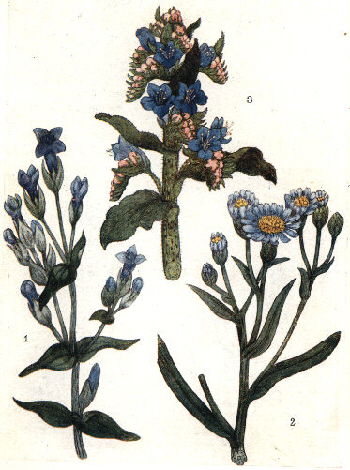 1. FIELD GENTIAN. 2. SEA ASTER.
1. FIELD GENTIAN. 2. SEA ASTER. The Field Gentian is to be found in damp pastures all over the country, especially in Scotland, where it is very plentiful. It blooms in late summer and autumn.
It is a stout, upright plant, but not very tall. The short stalks, which fork from the main stem and bear the flowers, stand straight up very stiffly, and the main stem itself is very firm, and has ridges running from top to bottom.
The flowers grow singly, each on its own stalk. They consist of four lilac-blue petals with the lower parts joined together to form a tube.
At the top of this tube, the petals fold back in four points, and within the tube, standing close up round the mouth, there is a blue fringe.
Inside the blue tube are four stamens clinging to its sides, as well as an upright, green seed-vessel.
The four bluey-green sepals are unequal in size. The two inner ones are narrow, with pointed ends; the outer sepals are much broader, and they are blunt at the tip.
The dark green leaves grow in pairs, opposite each other, and they clasp the main stem closely. These leaves taper to a point, and have long veins running from the broad part to the tip.
There is very often a single flower-bud growing close to the stem, where the leaves meet.
This somewhat dingy-looking plant loves to grow in muddy salt marshes close to the seashore; you find it in bloom all round our sea-coasts in autumn.
The Sea Aster is a stout, coarse plant, with straight, stiff stems which are ribbed from top to bottom. The dark green leaves are shaped like a sword, and as they have no stalks, they clasp this rough stem closely on alternate sides. These leaves are thick and fleshy, with smooth edges.
The flowers grow on short stalks, in dense heads which branch from the upper part of the main stem. These heads are made up of two kinds of flowers. In the centre you find a crowded mass of tiny yellow tube-flowers which are evenly notched all round the mouth. And outside these yellow flowers is arranged a double ring of tiny tubes, each of which has a broad, blue strap at one side. These blue straps stand out like a frill all round the centre bouquet of yellow flowers.
These flower-heads are placed in a green cup, composed of row upon row of small green pointed leaves, laid closely one above the other, like the scales of a fir-cone.
After the flowers are withered, the seeds still cling to the end of the stalk, and each seed is winged with a tuft of dingy white cotton down. When the seeds are ripe, the wind blows them away from the plant.
The first thing you will notice about the Viper's Bugloss is the way the rows of flower-buds curl like a scorpion.
The plant is common in most parts of the country, in waste places, by shingly sea beaches, and on chalky soil. It flowers in summer and autumn.
The Viper's Bugloss is a stout, upright plant, with a curious pale green hairy stem, which is dotted all over with red spots. From this thick stem others, small and thin, branch on alternate sides, and drooping from the end of each stem is a double row of bright pink buds. The pair of buds nearest the main stem open first, and when in full bloom the flowers are usually bright blue, but sometimes you will find them deep purple or white. These flowers are bell-shaped and they open wide at the mouth, which is unevenly divided into five graceful points.
Each flower sits in a green calyx-cup edged with five sharply pointed teeth.
There is a row of narrow green pointed leaves, standing up like a cockscomb behind each row of flowers. These leaves curl over at the tip, along with the buds, and they uncurl as the flowers open.
The leaves of the Viper's Bugloss are rough and hairy, with smooth edges.
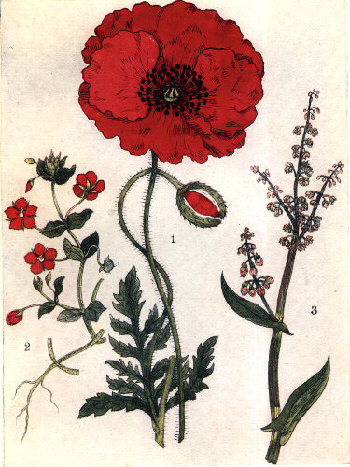 1. RED POPPY 2. SCARLET PIMPERNEL
1. RED POPPY 2. SCARLET PIMPERNEL The Red Poppy is known and beloved by children. You find it in all parts of the country in summer and autumn, growing among the corn, on the railway banks and under the hedges.
The flower has four bright red petals, and of these the two outer are larger than the two inner.
These petals are soft and silky, with wavy edges. When they first burst their green covering they are tightly folded and are much crinkled all over. But after a day in the sunshine they unfold, and all the crinkles disappear.
Sometimes you find a bright purple spot at the bottom of each scarlet petal.
In the centre of the flower sits a curious green cup with a lid, and this lid is covered with dark rays which look like the legs of a spider. This green cup is the seed-vessel, and as soon as the seeds are ripe, they pour out through a row of little holes which open just beneath the green lid.
There is a ring of black-headed stamens standing up all round the green seed-cup.
The Red Poppy has two green sepals. These are very thin and hairy, and they drop off almost as soon as the flower opens.
Each Poppy grows on a long slender stalk which is covered with hairs. The leaves are divided into many narrow fingers, and they are rough and hairy.
This fragile plant is very common. You find it in cultivated fields as well as by the roadside and in waste places. It blooms in summer and autumn.
This Scarlet Pimpernel is one of our few red flowers. It has five round scarlet petals, which are joined together like a wheel. In the centre of the wheel there is a seed-vessel, the size of a tiny green pea, and closely clustered round its thread-like pillar are five yellow-headed stamens. The slender stalks of the stamens are covered with hairs, and so are the edges of the scarlet petals.
The calyx consists of five narrow green sepals, with sharp points: these you can see appearing between the edges of the petals as you look down into the flower.
Each flower grows singly on a short, fine stalk, and these flower-stalks always rise between a leaf and the stem. The stem is four-sided, and it is very easily broken. It is a very feeble stem, and straggles along the ground.
The leaves of the Scarlet Pimpernel are small and oval, with smooth edges and blunt points. They have fine lines running from base to tip, and underneath they are a blue-green colour, with little dots all over them.
You find the dull crimson Sorrel everywhere. It grows in meadows and pastures and open woods, and it is abundant all spring and summer.
The flowers are small and unattractive. They grow on a spike in whorls or circles, with five to eight flowers in each circle, and these circles are separated at short distances.
Each flower droops from a tiny stalk. It has three narrow green sepals, which fold back close to the stalk when the seed is ripening. Inside these sepals are three dull crimson petals, also small and narrow. But when the flowering time is past, these three petals grow broad and oval, and become thicker, and at the base of each petal you see a tiny swelling, which is the seed.
The stem of the Common Sorrel is tinged with pink. It is ribbed all over, and is very juicy. Both it and the leaves are acid to taste and are often eaten in salads.
The leaves are quite smooth, with the edges uncut. They are dark green above, but much lighter underneath. Each leaf is shaped like an arrow-head, and those close to the root have a long stalk.
[Pg 152]
| Agrimony, Common, | 23. |
| Alkanet, Evergreen, | 144. |
| Anemone, Wood, | 47. |
| Angelica, Wild, | 56. |
| Asphodel, Bog, | 39. |
| Aster, Sea, | 147. |
| Autumnal Hawkbit, | 25. |
| Avens, Common, | 15. |
| Avens, Water, | 99. |
| Bedstraw, Yellow, | 32. |
| Bethlehem, Star of, | 73. |
| Bindweed, Small, | 128. |
| Birdsfoot Trefoil, | 17. |
| Biting Stonecrop, | 31. |
| Black Knapweed, | 107. |
| Bladder Campion, Common, | 79. |
| Bluebell or Harebell, | 138. |
| Blue Bottle or Corn Flower, | 135. |
| Blue Meadow Crane's-bill, | 133. |
| Bog Asphodel, | 39. |
| Borage, Common, | 143. |
| Broad-leaved Willow Herb, | 130. |
| Brooklime Speedwell, | 141. |
| Broom, | 12. |
| Bryony, Red-berried, | 84. |
| Bugle, Common, | 112. |
| Bugloss, Viper's, | 148. |
| Burdock, Greater, | 89. |
| Burnet Rose, | 125. |
| Butterbur, Common, | 88. |
| Buttercup, Bulbous, | 2. |
| Buttercup, Meadow, | 3. |
| Butterwort, Common, | 111. |
| Campion, Common Bladder, | 79. |
| Campion, Red, | 117. |
| Campion, Sea, | 80. |
| Carrot, Sea, | 61. |
| Celandine, Lesser, | 1. |
| Chervil, Wild, | 60. |
| Chickweed, Common, | 52. |
| Chickweed, Mouse-eared, | 53. |
| Chickweed, Wintergreen, | 85. |
| Cinquefoil, Creeping, | 21. |
| Cinquefoil, Marsh, | 98. |
| Cleavers or Goosegrass, | 66. |
| Clover, Red, | 123. |
| Coltsfoot, | 27. |
| Comfrey, Common, | 43. |
| Corn Cockle, | 131. |
| Corn Flower or Blue Bottle, | 135. |
| Cow Parsnip, | 59. |
| Cowslip, | 38. |
| Crane's-bill, Blue Meadow, | 133. |
| Crane's-bill, Dove's-foot, | 118. |
| Cress, Hairy Rock, | 51. |
| Cross-leaved Pink Heath, | 132. |
| Crosswort, | 30. |
| Crowfoot, Water, | 48. |
| Cuckoo Flower or Lady's Smock, | 97. |
| Cuckoopint or Wake Robin, | 86. |
| Daffodil, | 42. |
| Daisy, | 70. |
| Daisy, Ox-eye, | 69. |
| Dandelion, Common, | 35. |
| Dead Nettle, White, | 82. |
| Dog Rose, | 124. |
| Dog's Mercury, | 94. |
| Dog Violet, | 100. |
| Dove's-foot Crane's-bill, | 118. |
| Dropwort, Hemlock Water, | 58. |
| Early Purple Orchis, | 109. |
| Evergreen Alkanet, | 144. |
| Everlasting, Mountain, | 45. |
| Eyebright, Common, | 81. |
| Field Gentian, | 146. |
| Field Scabious, | 105. |
| Figwort, Knotty, | 92. |
| Fingers, Lady's, | 19. |
| Forget-me-not, Great Water, | 142. |
| Foxglove, | 129. |
| Fumitory, Common, | 115. |
| Gentian, Field, | 146. |
| Germander Speedwell, | 140. |
| Goatsbeard, Yellow, | 26. |
| Golden Saxifrage, Opposite-leaved, | 10. |
| Goosegrass or Cleavers, | 66. |
| Gorse or Whin, | 11.[Pg 153] |
| Goutweed, | 55. |
| Grass of Parnassus, | 78. |
| Grass, Scurvy, | 50. |
| Greater Burdock, | 89. |
| Greater Stitchwort, | 54. |
| Great Water Forget-me-not, | 142. |
| Great Wild Valerian, | 127. |
| Ground Ivy, | 113. |
| Groundsel, Common, | 28. |
| Hairy Rock Cress, | 51. |
| Hairy Water Mint, | 114. |
| Harebell or Bluebell, | 138. |
| Harrow, Rest, | 121. |
| Hawkbit, Autumnal, | 25. |
| Heartsease, | 101. |
| Heath, Cross-leaved Pink, | 132. |
| Heather or Common Ling, | 106. |
| Hedge Mustard, | 7. |
| Hedge Parsley, Upright, | 57. |
| Hemlock, Common, | 62. |
| Hemlock, Water Dropwort, | 58. |
| Herb-Robert, | 119. |
| Holly, Sea, | 139. |
| Honeysuckle, | 40. |
| Hop Trefoil, | 18. |
| Horned Poppy, Yellow, | 8. |
| Hyacinth, Wood, | 145. |
| Intermediate Wintergreen, | 77. |
| Iris, Yellow Water, | 41. |
| Ivy, Ground, | 113. |
| Joy, Traveller's, | 46. |
| Knapweed, Black, | 107. |
| Knotty Figwort, | 92. |
| Lady's Fingers, | 19. |
| Lady's Mantle, | 93. |
| Lady's Smock, | 97. |
| Lesser Celandine, | 1. |
| Ling, Common, or Heather, | 106. |
| Loose-strife, Purple, | 110. |
| Lousewort, or Red Rattle, | 126. |
| Mallow, Common, | 102. |
| Mantle, Lady's, | 93. |
| Mare's Tail, Common, | 87. |
| Marsh Cinquefoil, | 98. |
| Marsh Marigold, | 4. |
| Marsh Pennywort, | 76. |
| Marsh Plume Thistle, | 104. |
| Mayweed, Scentless, | 71. |
| Meadow Buttercup, | 3. |
| Meadow Crane's-bill, Blue, | 133. |
| Meadow Sweet, | 63. |
| Meadow Vetchling, | 20. |
| Mercury, Dog's, | 94. |
| Mignonette, Wild, | 34. |
| Milkwort, | 134. |
| Millfoil, or Yarrow, | 68. |
| Mint, Hairy Water, | 114. |
| Mossy Saxifrage, | 75. |
| Mountain Everlasting, | 45. |
| Mouse-eared Chickweed, | 53. |
| Mouse Tail, | 90. |
| Mugwort, | 33. |
| Mustard, Hedge, | 7. |
| Mustard, Wild, | 6. |
| Needle Whin, | 13. |
| Nettle, Common, | 95. |
| Nettle, White Dead, | 82. |
| Nipplewort, Common, | 24. |
| Opposite-leaved Golden Saxifrage, | 10. |
| Orchis, Early Purple, | 109. |
| Orchis, Spotted, | 83. |
| Ox-eye Daisy, | 69. |
| Parnassus, Grass of, | 78. |
| Parsley, Upright Hedge, | 57. |
| Parsnip, Cow, | 59. |
| Pennywort, Marsh, | 76. |
| Pimpernel, Scarlet, | 150. |
| Pink Heath, Cross-leaved, | 132. |
| Plantain, Ribwort, | 91. |
| Plume Thistle, Marsh, | 104. |
| Poppy, Red, | 149. |
| Poppy, Yellow Horned, | 8. |
| Primrose, | 37. |
| Purple Loose-strife, | 110. |
| Purple Orchis, | 109. |
| Purple Sea Rocket, | 96. |
| Purse, Shepherd's, | 49. |
| Ragged Robin, | 116. |
| Ragwort, Common, | 29. |
| Ransoms, | 74. |
| Red-berried Bryony, | 84. |
| Red Campion, | 117. |
| Red Clover, | 123. |
| Red Poppy, | 149.[Pg 154] |
| Red Rattle, or Lousewort, | 126. |
| Rest Harrow, | 121. |
| Ribwort Plantain, | 91. |
| Robert, Herb, | 119. |
| Rock Cress, Hairy, | 51. |
| Rocket, Purple Sea, | 96. |
| Rock Rose, | 9. |
| Rose, Burnet, | 125. |
| Rose, Dog, | 124. |
| Saintfoin, | 122. |
| St. John's Wort, | 14. |
| Saxifrage, Mossy, | 75. |
| Saxifrage, Opposite-leaved Golden, | 10. |
| Scabious, Field, | 105. |
| Scarlet Pimpernel, | 150. |
| Scentless Mayweed, | 71. |
| Scotch Thistle, | 103. |
| Scurvy Grass, | 50. |
| Sea Aster, | 147. |
| Sea Campion, | 80. |
| Sea Carrot, | 61. |
| Sea Holly, | 139. |
| Sea Rocket, Purple, | 96. |
| Shepherd's Purse, | 49. |
| Silver Weed, | 22. |
| Small Bindweed, | 128. |
| Smock, Lady's, | 97. |
| Sneezewort Yarrow, | 44. |
| Snowdrop, | 72. |
| Sorrel, Common, | 151. |
| Sorrel, Wood, | 65. |
| Speedwell, Brooklime, | 141. |
| Speedwell, Germander, | 140. |
| Spotted Orchis, | 83. |
| Star of Bethlehem, Common, | 73. |
| Stitchwort, Greater, | 54. |
| Stonecrop, Biting, | 31. |
| Stork's Bill, | 120. |
| Strawberry, Wild, | 64. |
| Succory, Wild, | 137. |
| Sweet, Meadow, | 63. |
| Tail, Common Mare's, | 87. |
| Tail, Mouse, | 90. |
| Tansy, | 36. |
| Thistle, Marsh Plume, | 104. |
| Thistle, Scotch, | 103. |
| Thyme, Wild, | 108. |
| Tormentil, | 16. |
| Traveller's Joy, | 46. |
| Trefoil, Birdsfoot, | 17. |
| Trefoil, Hop, | 18. |
| Tufted Vetch, | 136. |
| Upright Hedge Parsley, | 57. |
| Valerian, Great Wild, | 127. |
| Vetchling, Meadow, | 20. |
| Vetch, Tufted, | 136. |
| Violet, Dog, | 100. |
| Viper's Bugloss, | 148. |
| Wake Robin, or Cuckoopint, | 86. |
| Wallflower, | 5. |
| Water Avens, | 99. |
| Water Crowfoot, | 48. |
| Water Dropwort, Hemlock, | 58. |
| Water Mint, Hairy, | 114. |
| Water Iris, Yellow, | 41. |
| Weed, Silver, | 22. |
| Whin, or Gorse, | 11. |
| Whin, Needle, | 13. |
| White Dead Nettle, | 82. |
| Wild Angelica, | 56. |
| Wild Chervil, | 60. |
| Wild Mignonette, | 34. |
| Wild Mustard, | 6. |
| Wild Strawberry, | 64. |
| Wild Succory, | 137. |
| Wild Thyme, | 108. |
| Wild Valerian, Great, | 127. |
| Willow Herb, Broad-leaved, | 130. |
| Wintergreen, Chickweed, | 85. |
| Wintergreen, Intermediate, | 77. |
| Wood Anemone, | 47. |
| Wood Hyacinth, | 145. |
| Woodruff, | 67. |
| Wood Sorrel, | 65. |
| Wort, St. John's, | 14. |
| Yarrow, or Millfoil, | 68. |
| Yarrow, Sneezewort, | 44. |
| Yellow Bedstraw, | 32. |
| Yellow Goatsbeard, | 26. |
| Yellow Horned Poppy, | 8. |
| Yellow Water Iris, | 41. |
Edinburgh: Printed by T. and A. Constable